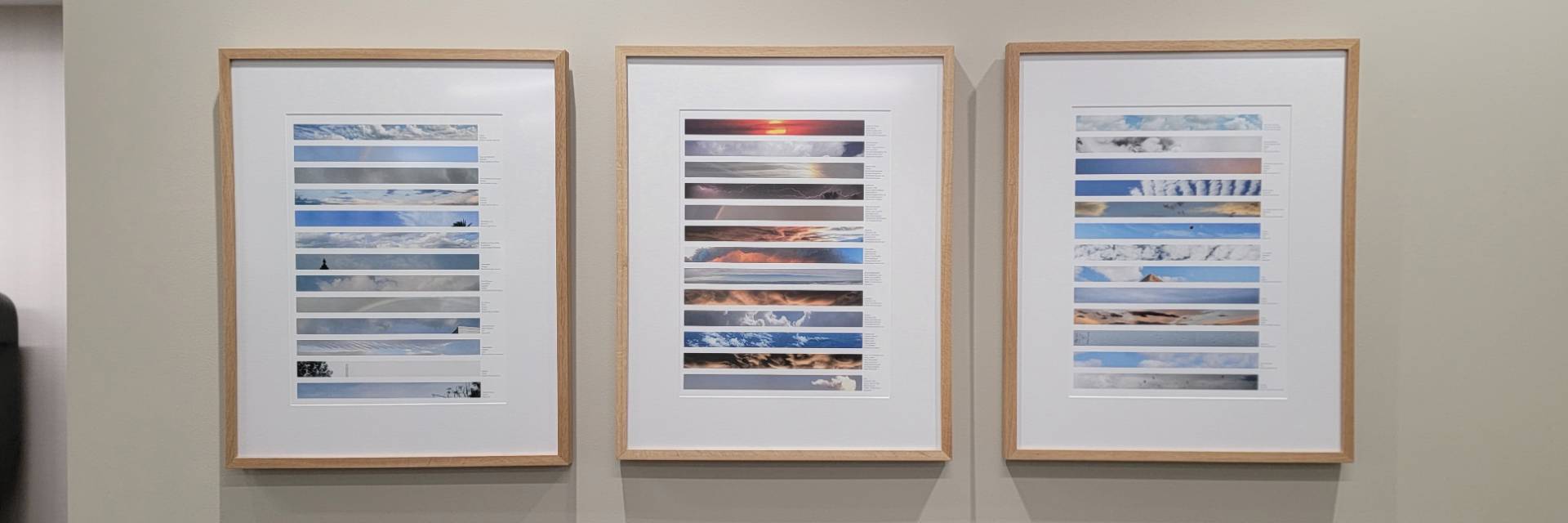
Artworks
Living Art Museum: A virtual gallery of works displayed throughout the MU.
"The artwork selected for the Memorial Union has been carefully curated by the 2022 spring semester Intro to Fine Arts Honors course students. They spent much of the semester researching artwork and artists that they felt represented the values of the student body and greater University population. Ideas of community, inclusion, and fun were incorporated into their curatorial activities. They identified themes for each floor of the union, considering the purposes of each space. These themes guided the intentional choices and written statements for each floor and its artwork.
Prints and drawings have been prepared with archival framing materials. Paintings have been framed where appropriate. We recognize that occasionally art is curated that may make viewers uncomfortable or may seem controversial. However, as the instructor for this course, I have emphasized to the students that there are many ways to view and interpret artwork and have encouraged them to present their thoughts professionally and with the spirit of inclusion in mind."
- Sarah Heitkamp, Curator and Director of UND Art Collections
"The overall goal of our project, curating artwork for the newly constructed Memorial Union, is very simple. Our class was tasked with transforming this new and exciting building into a welcoming place that feels like home for our students: a place that will serve as the heart of campus for years to come. We had to take many factors into consideration, like the history of the artist, the intended meaning of a piece, how the art will be received by our student body as a whole, and how the art will fit in various spaces throughout the Union, all with different purposes and uses. For example, the lower level needs artwork that captures the energy of the space, which is used for recreation and games. Being the center of campus, this building is home to a lot of resources and services, and serves many different purposes; therefore, it calls for a very broad and diverse collection of artworks. Choosing pieces for the Memorial Union took a lot of thought and consideration and was definitely a group effort."
- Austin Pierce, on behalf of the Spring 2022 FA150HON class
First Floor Art
The first floor of the Memorial Union is where the first impression is made – it features the food court where students often come together to socialize and indulge or grab a cup of coffee. It is where the student government and involvement offices are located as well as the Memorial Union Art Gallery.
One of the most trafficked areas of campus, the Union is truly the heart of UND. It was built for the students and will always be a place where everyone is welcome. This idea was the foundation of the UND Memorial Union Art Project curated by the students themselves for their fellow classmates and the campus community. Every piece of art in this building was hand-picked by students to represent the feelings and values of this building, and everywhere you look, the art will capture your attention by being relevant to where you are.
For this floor we really wanted to focus on the Union's main purpose as a place to gather. In the food court area, we chose pieces that showcase various foods such as a sandwich that ties in with the deli. Additionally, a coffee pot print near the common area might encourage viewers to visit Starbucks. Other works feature familiar scenes, such as James Asiata’s vibrant and tactile painting of Odegard and surrounding buildings. The pieces we curated for the first floor compliment rather than take away from the building's beautiful architecture.
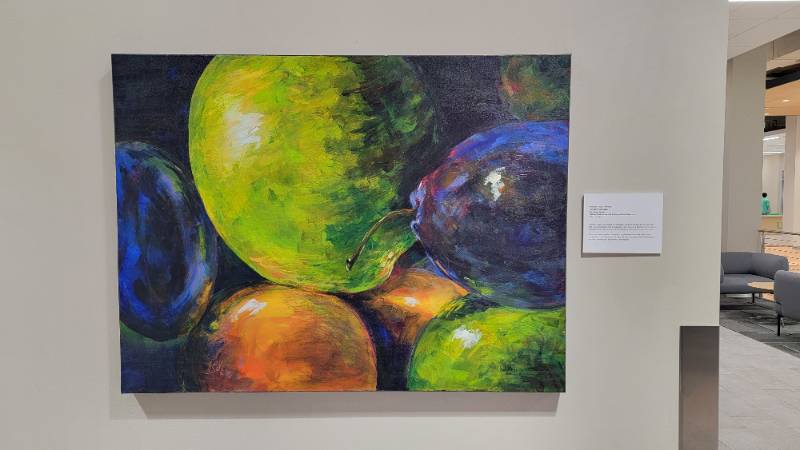
Michelle Roise, who resides in Minnesota, has been an artist for over 40 years and has a long history with art education. She received a Bachelor of Fine Arts in Visual Arts from the University of North Dakota, where she donated this piece.
This acrylic painting depicts large fruit toppled over each other over a dark background. Like the objects in a night sky, this fruit floats along, shimmering in the dark, drawing your eye toward it and beyond.

In this silkscreen print by Shelly Lord, a beautiful purple cabbage is featured. This
art is unique because, while it resembles cabbage, it also possesses a certain abstractness
and does not as literally look like the vegetable, especially when compared to Mary
Weaver’s prints, also on display in this space. The colors purple and gold are traditionally
associated with royalty, perhaps reminding the viewer of the importance of vegetables
in their diets.
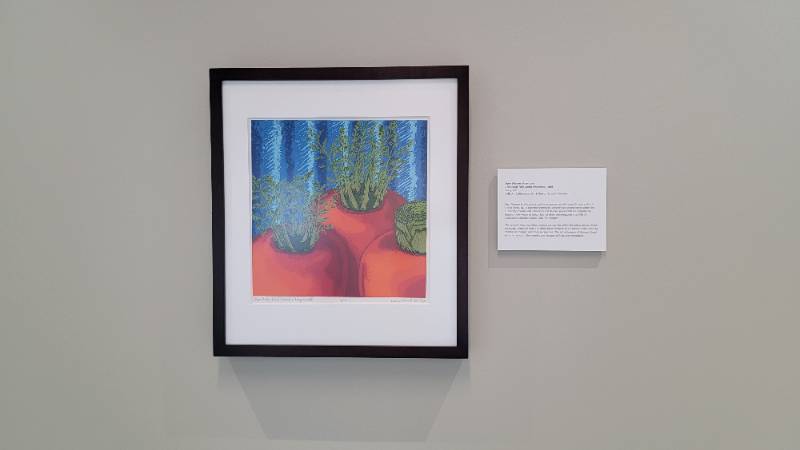
Mary Weaver is a local artist and businesswoman who owns Browning Arts in Grand Forks,
ND. A talented printmaker, Weaver has several works within the University’s permanent
collections and has two pieces that are currently on display in the Memorial Union,
both of which were featured in a UND Art Collections exhibition called Food For Thought.
This artwork, featuring vibrant orange carrots, fits well in the dining center, which considers themes of food. The artist draws attention to the details of the carrot by sharing an enlarged and close perspective. The attractiveness of Weaver’s food prints remind us of the benefits and vibrancy of fruits and vegetables.
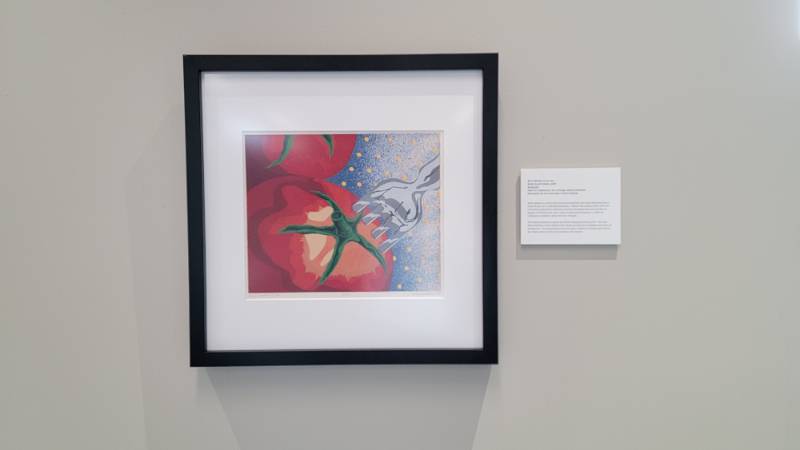
Mary Weaver is a local artist and businesswoman who owns Browning Arts in Grand Forks,
ND. A talented printmaker, Weaver has several works within the University’s permanent
collections and has two pieces that are currently on display in the Memorial Union,
both of which were featured in a UND Art Collections exhibition called Food For Thought.
This artwork features a plump red tomato being pierced by a fork. The artist draws attention to the details of the tomato by sharing an enlarged and close up perspective. The attractiveness and rich color of Weaver’s tomato print remind the viewer what it is like to be at home in the kitchen.
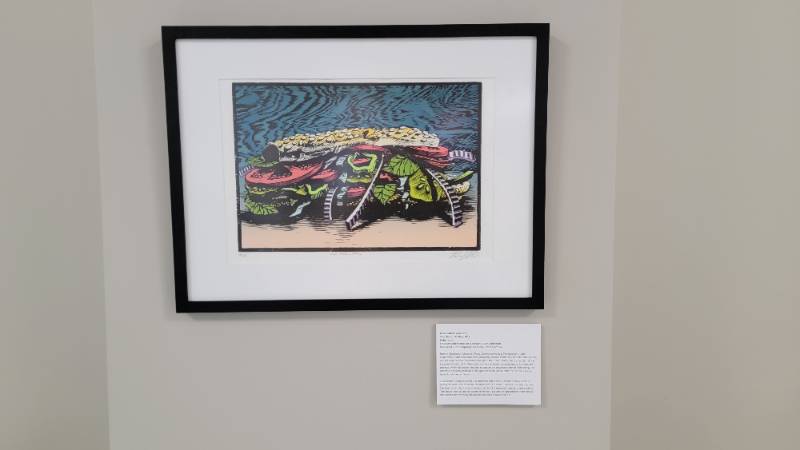
Born in Cedarburg, Wisconsin, Ross Jahnke serves as a Professor of Art and Department
Head at Nicholls State University. Jahnke is both a print maker and painter, and his
work has been exhibited throughout the United States. He is a recipient of the Louisiana
Division of Art Fellowship and has received numerous grants for visual art projects.
Within his artwork, he tries to capture the traditional roots of printmaking. His
attention is typically focused on the grain of wood, whose patterns become a leading
factor for various surfaces.
Gas Station Po’Boy is a print of a sandwich and is one of Jahnke’s many prints. A po’boy sandwich is a traditional sandwich from Louisiana. This French bread sandwich has been a favorite at various restaurants, but it is especially popular at gas stations. The image’s use of brightly colored ink lends a cartoon-ish appearance to the image, that entices the viewer by making the food look creative and fun.
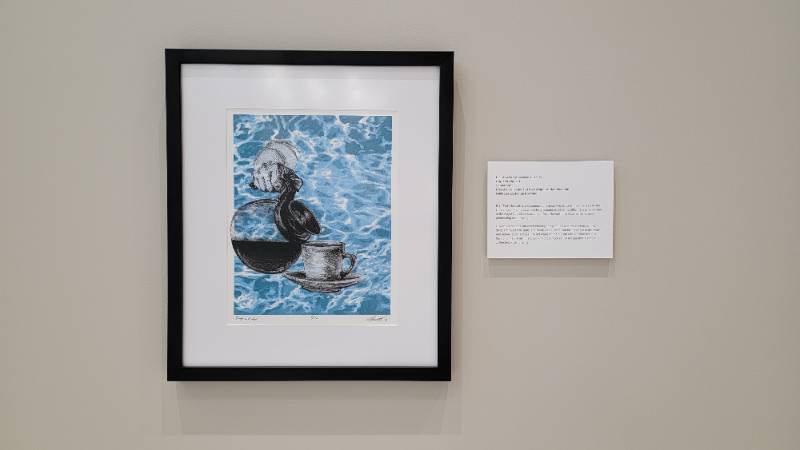
E.J. “Ted” Howorth is a Canadian-born artist, who is currently employed by the University
of Manitoba, where he graduated in 1969. In 1995, he was appointed to the Royal Canadian
Academy of Arts. Howorth now lectures full-time in printmaking and drawing.
Howorth explained that when creating this print, he was focused on natural disasters caused by man. The result was a piece that brought light to the issue and served as an escape: the hot water brings out the oils in coffee that give it flavor. To the viewer, this artwork might symbolize the escape that a simple coffee break can provide.
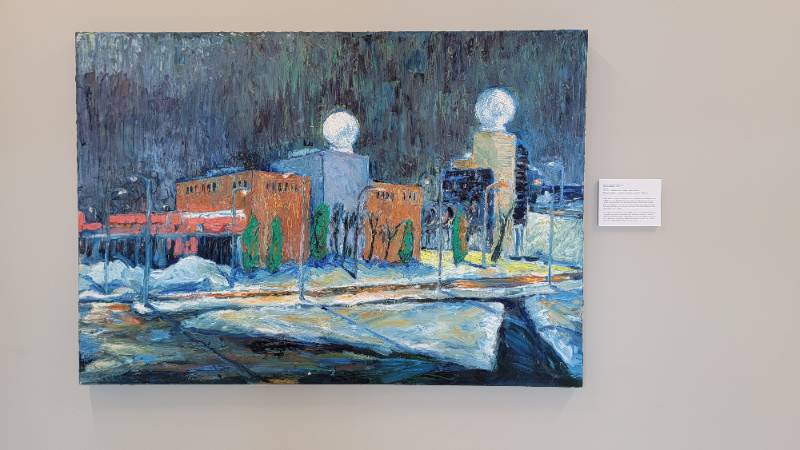
James Asiata is a former student of UND and attended campus during the 1990s. In 1996,
he received his Bachelor of Fine Arts from the Department of Art and Design. Asiata
then went on to graduate school in his native country of New Zealand. Emphasizing
color and brush strokes, Asiata incorporated the abstract expressionism style into
his paintings. Much of this was done through his use of applying thick layers of paint.
This large painting created by Asiata in 1996 features a part of the UND campus. The buildings in the night-time winter scene are two of the John D. Odegard School of Aerospace buildings. Odegard Hall is on the left and Clifford Hall on the right. Though it is a night setting, Asiata utilized many bright and bold colors to ensure the vivid brush stroke detail was easy to see.
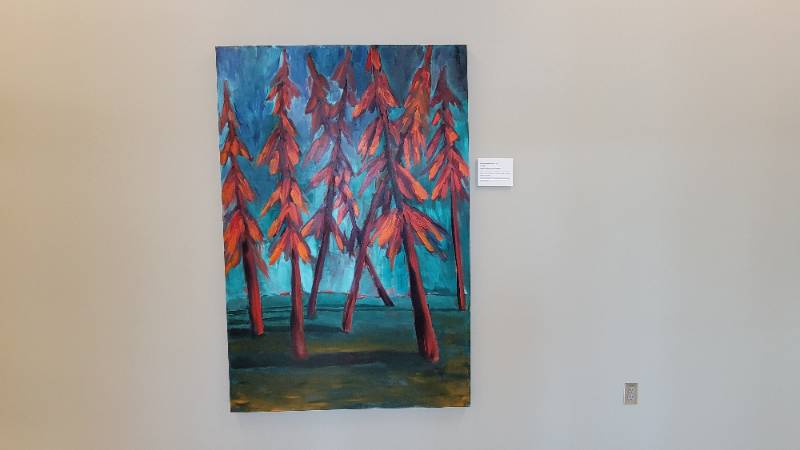
Sister Denise Schonhardt earned a Bachelor’s degree in History and Secondary Education
from the University of Mary in Bismarck, North Dakota, and eventually produced this
piece of art on her way to earning a Master of Fine Arts from the University of North
Dakota.
Sister Denise Schonhardt lives at the Mount Saint Benedict Monastery in Crookston, Minnesota.
The painting was executed by Schonhardt when she was a graduate student in the Visual Arts program at UND, where she received an MFA degree.
This large oil painting depicts a dark forest with bright orange trees in contrast. Each tree leaning and showing a color unexpected, still stands tall and catches the eye, encompassing the viewer with its large scale. For these trees, being different is being seen.
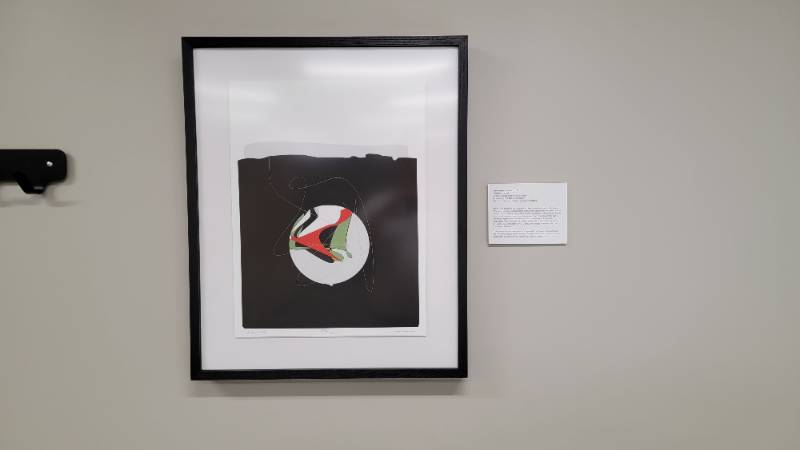
David Ryan studied at the University of Texas where he earned his Bachelor of Fine
Arts. He took a special interest in household appliances, electronics, and the unique
colors and lines of cars which is where a majority of his inspiration comes from,
as a former electromechanical engineer. Ryan presents complex and theoretical approaches
in his works that focus on a legacy of American abstraction. Ryan’s work can be found
in collections such as the Design Center in London, the Manchester City Art Gallery,
the Chicago Athenaeum, and the Tacoma Art Museum.
This artwork demonstrates the artist’s approach to art theories, shown through his line work, shaping, and complexity. His approach focuses on the explorative relationship between man and machine and art and design.
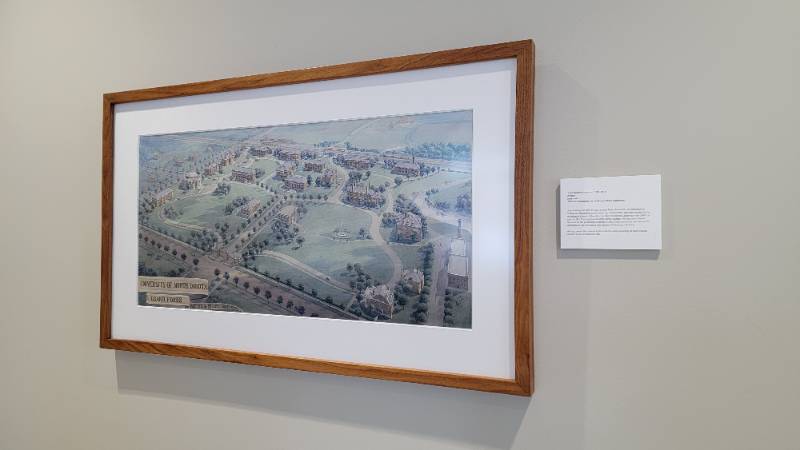
Lloyd Harting was born in 1901 in Little Falls, Minnesota. He attended the College
of Engineering at the University of Minnesota, and then studied at the Minneapolis
School of Fine Arts. He later traveled to California in the 1940s to work for 20th
Century Fox and Walt Disney Studios. He was one of the Art Directors for the production
of Bambi in 1942. After some time, he returned to Minnesota to work for Brown and
Bigelow Publishing in St. Paul.
Harting created this artwork to illustrate the early University of North Dakota campus for an architectural firm.
Second Floor Art
Because the Memorial Union serves as a gathering place for the student population at the University of North Dakota, the art selections on the second floor aim to embody a sense of community. To reflect this, artwork has been chosen with the intent of representing the campus community and beyond through both the subjects depicted by the art and the artists that created these pieces. Inclusion and community are two important aspects of the University of North Dakota and the wider community, and this is these values are central to the curatorial theme of the second floor.
The second floor of the Memorial Union is home to offices such as The Hilyard Center and the UND Pride Center. This has inspired a selection of colorful, varied artworks that aim to represent the different communities that have come together as one at the University. The artworks also promote themes of peace and inclusion that elevate the role of UND as a place where everyone is welcome. With this in mind, we chose works such as Shared Skies by Kim Abeles, who shows us that no matter where we are from, we all live under a shared sky, and Rainbow Daphne, by feminist icon Audrey Flack, who visited UND in 2015. While artwork by Indigenous artists is placed throughout the entire building, incredible works by former students David Thunderhawk, Bennet Brien, and world-renown artist Jaune Quick-to-See Smith live on this floor. With the addition of these artworks, values of community and inclusion resonate throughout the halls of the Memorial Union’s second floor.
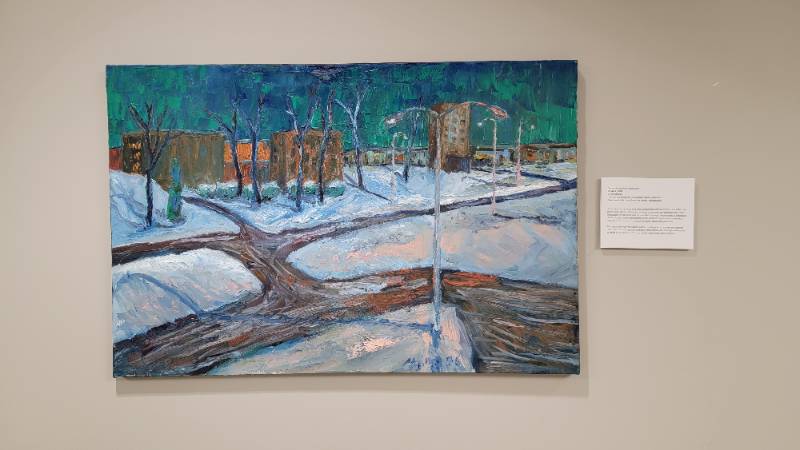
James Asiata is an artist from New Zealand that attended UND in the 1990s. He received
his Master of Fine Arts in Visual Art in 1996. His paintings often reflect landscapes
he has seen, and he uses thick, dramatic brushstrokes to emphasize details. Asiata’s
style is reminiscent of the Abstract Expressionist movement, using gestural strokes
to compose the scene, rather than precision.
This piece, like many of Asiata’s works, uses large brush strokes and abstract color. The dark curving paths and dark night contrast with the bright white snow to create an abstract but still once familiar scene from UND’s campus.
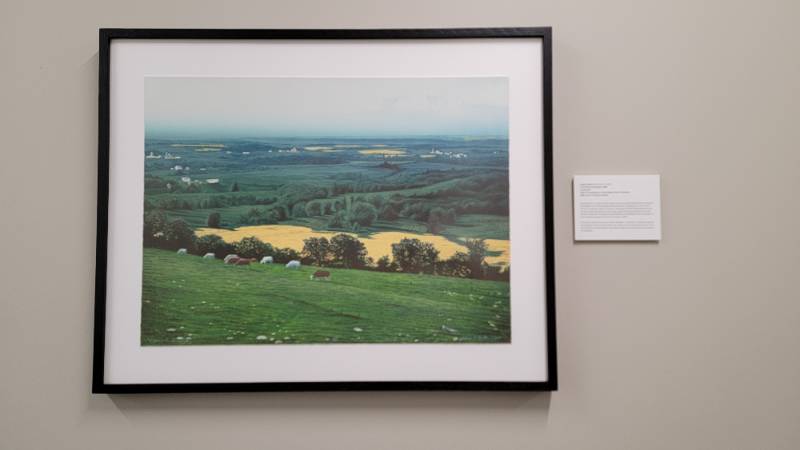
James Butler is a native of Fort Dodge, Iowa but earned his Bachelor of Science and
Master of Fine Arts degrees at the University of Nebraska in Omaha and Lincoln respectively.
Much of his art is influenced by both the Baroque and Pop Art eras, which has led
him to the unique style of mod printmaking that he has become known for. His artwork
was featured in an exhibition in the University of North Dakota’s Department of Art
& Design in 1989.
Featured at the 2014 Farmers Choice Exhibition, A Summer Landscape captures a landscape of several rolling fields upon which cows are depicted grazing. Much like the fields of North Dakota, this artwork evokes a sense of peace and serenity in its stillness.
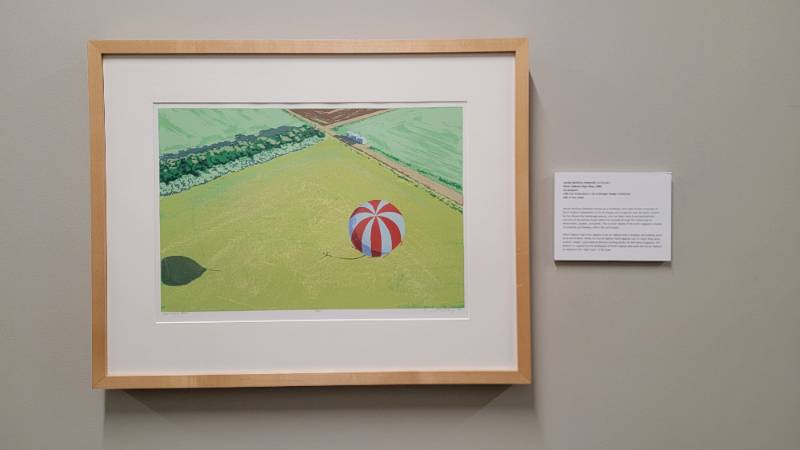 Jackie McElroy is a former Professor and Chair of the University of North Dakota Art
Department. The work was inspired by the landscape of eastern North Dakota. Produced
as part of the portfolio to commemorate UND’s centennial, it focuses on the flatness
of the local terrain and perhaps whimsically comments on the lack of high rise buildings
within the city of Grand Forks.
Jackie McElroy is a former Professor and Chair of the University of North Dakota Art
Department. The work was inspired by the landscape of eastern North Dakota. Produced
as part of the portfolio to commemorate UND’s centennial, it focuses on the flatness
of the local terrain and perhaps whimsically comments on the lack of high rise buildings
within the city of Grand Forks.
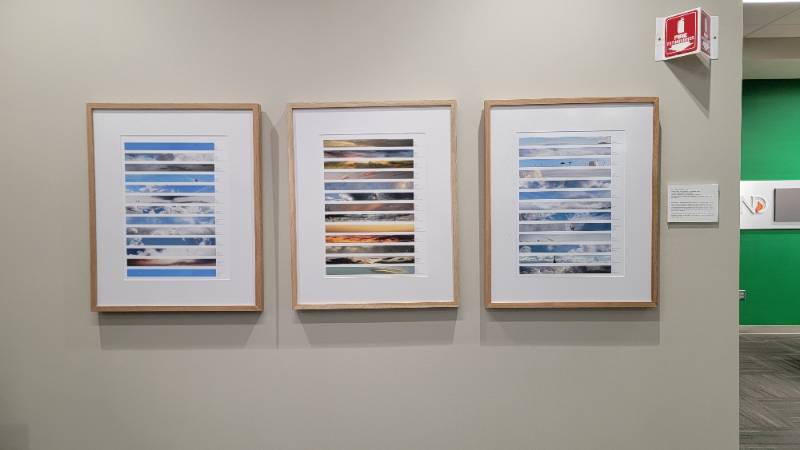
Kim Abeles is a photographer and artist. Many of her works are related to social issues
that explore geography, feminism, and environmentalism. She mixes different media
to explore the relationship between urbanism and social issues. The Shared Skies prints
were created as part of the Binary Inventions portfolio, which was produced for and
exhibited during the 2012 University of North Dakota Arts & Culture Conference.
Shared Skies reminds us that we all live under the same sky. Even if the photos were taken thousands of miles apart, it is the same sky that connects us as all as humans to each other.
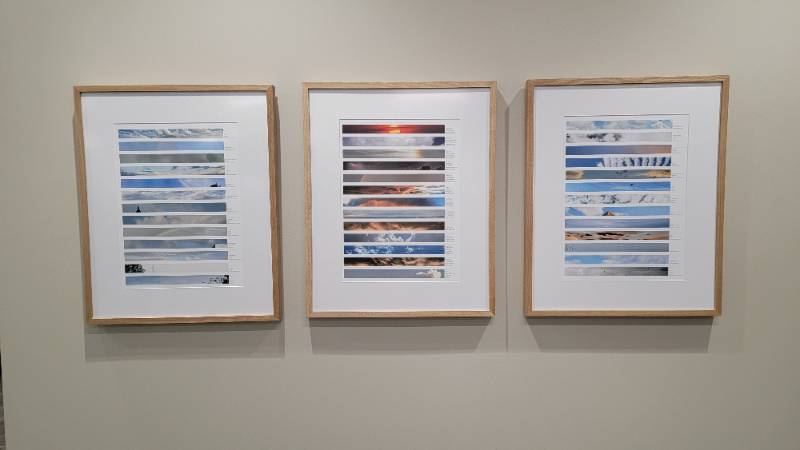
Kim Abeles is a photographer and artist. Many of her works are related to social issues
that explore geography, feminism, and environmentalism. She mixes different media
to explore the relationship between urbanism and social issues. The Shared Skies prints
were created as part of the Binary Inventions portfolio, which was produced for and
exhibited during the 2012 University of North Dakota Arts & Culture Conference.
Shared Skies reminds us that we all live under the same sky. Even if the photos were taken thousands of miles apart, it is the same sky that connects us as all as humans to each other.
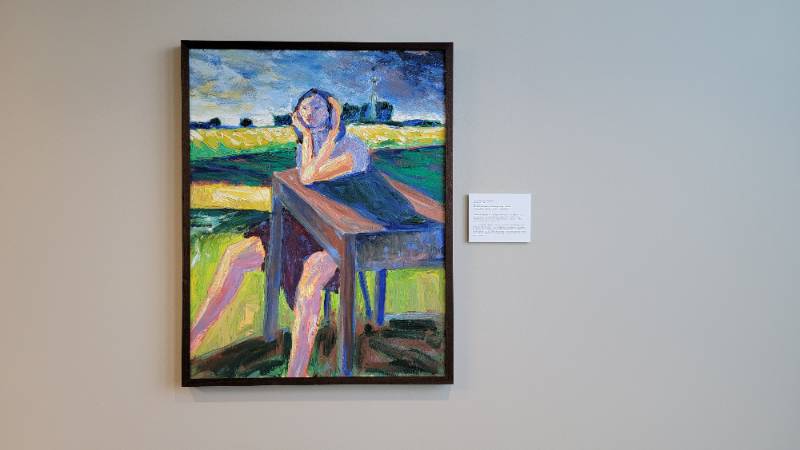
James Asiata attended the University of North Dakota in the 1990s. He was a graduate
student from New Zealand whose work was inspired by abstract expressionist movement.
He enjoyed the challenge of creating art in different styles and using color in interesting
ways.
In this piece, we see a woman sitting at a table or desk that is seemingly in the middle of a field. The scenery is very familiar to us in the Midwest, rolling fields with varying shades of green. We cannot see what the woman is looking at, she may be watching over her children as they play, enjoying some peace and quiet after a long day, or perhaps she’s daydreaming of being somewhere else while at work or school.
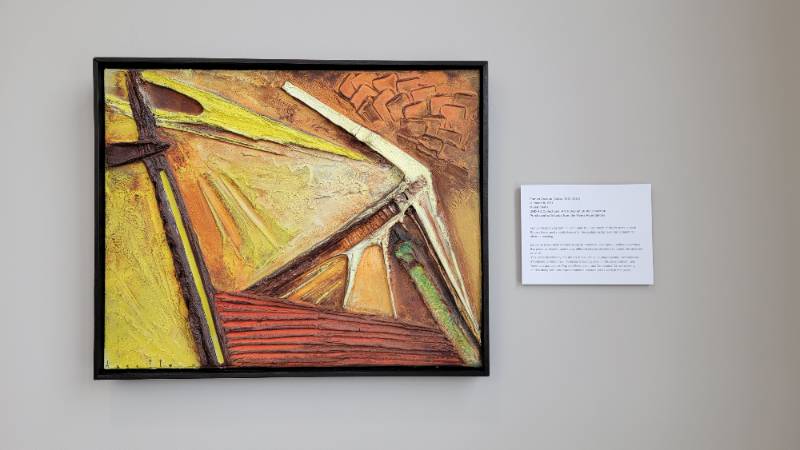
Franco Assetto was born in Turin, Italy but lived much of his life in the United States.
He is most notably known for his sculptures but also had a talent for abstract painting.
Le Jaune II is French and translates to “Yellow II” in English. “Yellow” describes this piece as Assetto used many different shades of yellow to create this abstract artwork.
This piece ties directly into the art of the 1960’s. During that time, America was introduced to many new influences including, rock n’ roll, consumerism, and American pop culture. Pop art, Minimalism, and Conceptual Art were taking strides along with non-representational abstract art as seen in this piece.
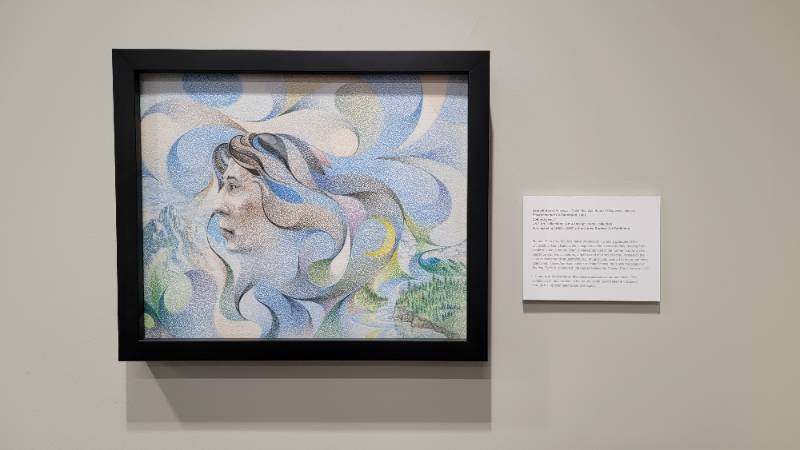
Bennett Brien was born in 1957 in Belcourt, North Dakota. He received his BFA and
MFA degrees in sculpture at the University of North Dakota. Brien’s work incorporates
his heritage and reflects pride in Native American traditions.
Brien received additional attention recently when several of his works were included in the national award-winning book, Storytelling Time: Native North American from the Collections at the University of North Dakota, which was published by University of North Dakota Art Collections in association with Hudson Hills Press in 2010.
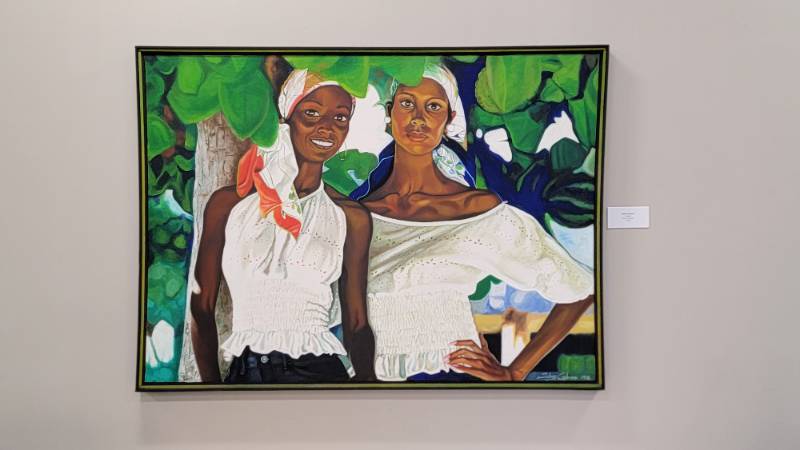
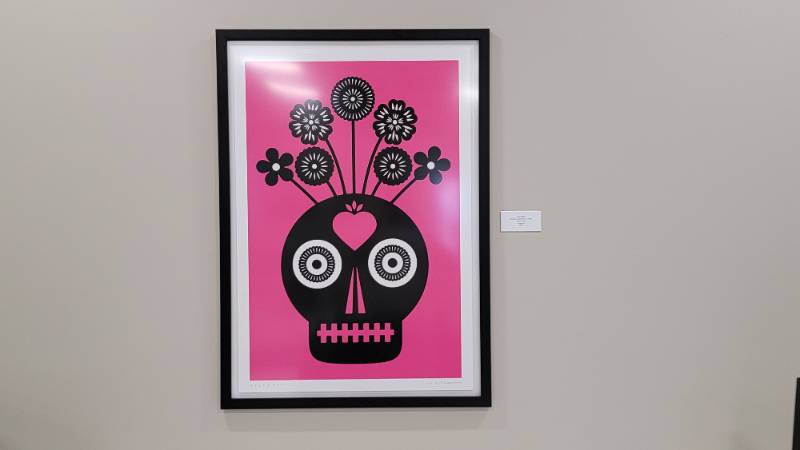
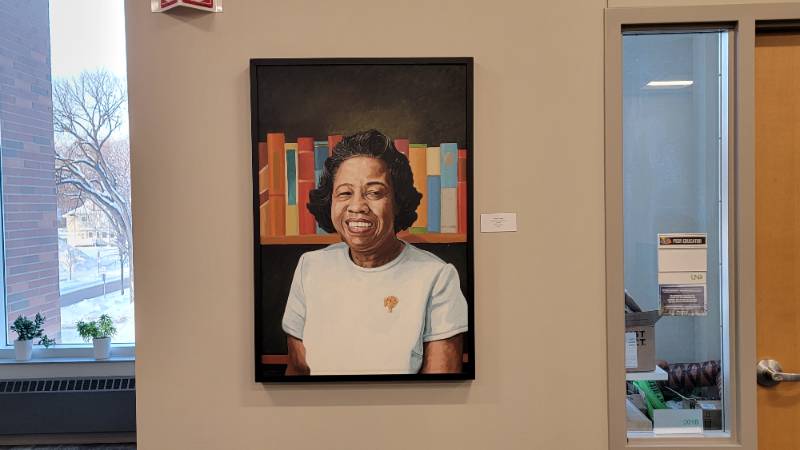
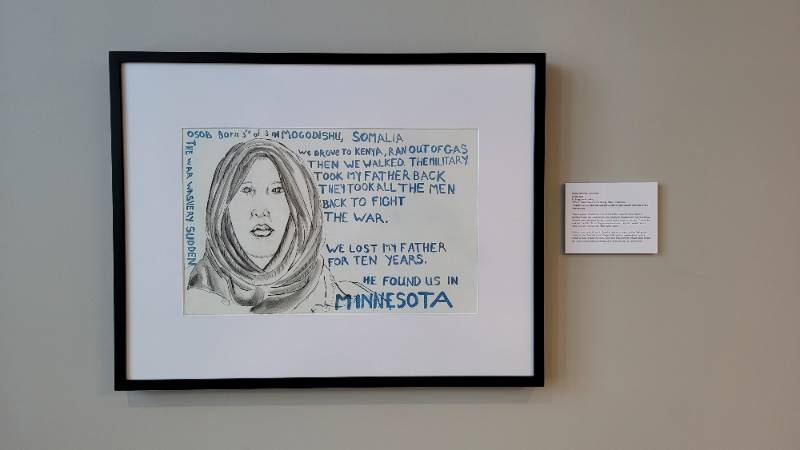
Daniel Heyman, a Professor of Art at Princeton University, has worked in partnership
with the University of North Dakota on multiple print-making projects. His work often
addresses issues of social justice, violence, and war. Through his work with the John
Simon Guggenheim foundation, Heyman created pieces referencing the Iraq war and other
social issues.
Political unrest and civil war in Somalia have led to many families fleeing their country in search of safety and refuge. In this piece, Heyman gives a young woman a voice to share her story. This piece expresses the impact social conflict can have on individuals and groups, and the forces that can reunite them.
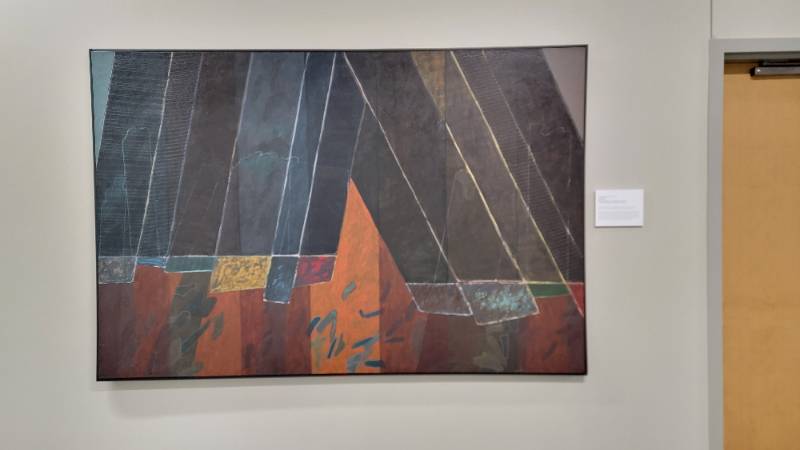
Peter Lockrem, who was raised in Thief River Falls and Grand Forks, now lives in California.
He received his BFA in Art at the University of North Dakota, his MS in Environmental
Design at Southern Illinois University and his MFA in Art at the University of Wisconsin-Madison.
After completing his degrees, Lockrem did not pursue an art career. Even so, he affirms
that his visual background has helped him in his chosen profession as a software quality
assurance engineer.
This oil painting was created in the 1970’s which was a very controversial time in American History known for the counter-culture and social justice movements, the Vietnam War, and student protests across America. It was also the beginning of the contemporary art movement that embraced non-representational art. The focus of this piece lies in the major divide in the middle, serving as a metaphor for the divide and unrest that plagued America during this time period.
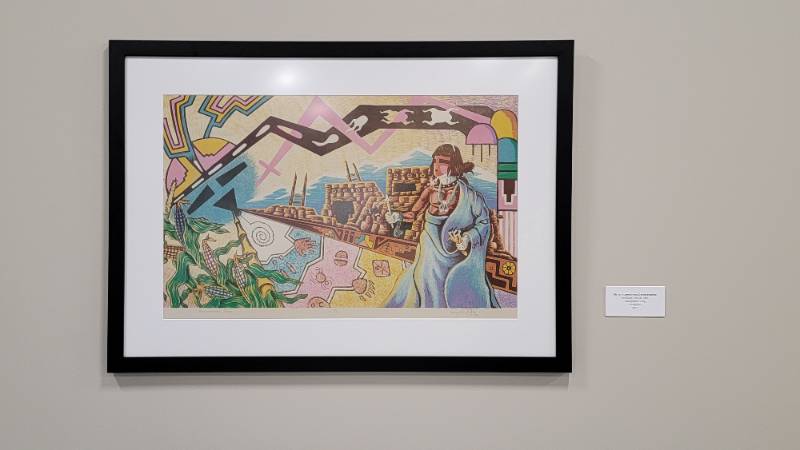
Richard Lomahinma Dawavendewa was born and raised in the Hopi village of Moenkopi,
Arizona, but came to North Dakota to pursue an MFA at UND.
Dawavendewa’s work is deeply symbolic, conveying elements of his life experience as a Hopi. He credits his grandfather, an esteemed elder in his community, for instilling within him a deep respect for his culture.

During his first year in Paris after fleeing Spain at the eruption of the Spanish
Civil War, Miro was tasked to create a work for the first issue of the Paris-based
Verve Magazine. Miro was one of four artists who each chose one of the four elements
as inspiration for their work for this publication.
Like many of his works during this period, L’air is thought to take some influence from the Spanish Civil War; particularly the ‘scorched’ ground and grotesque figures pictured towards the bottom of the work.
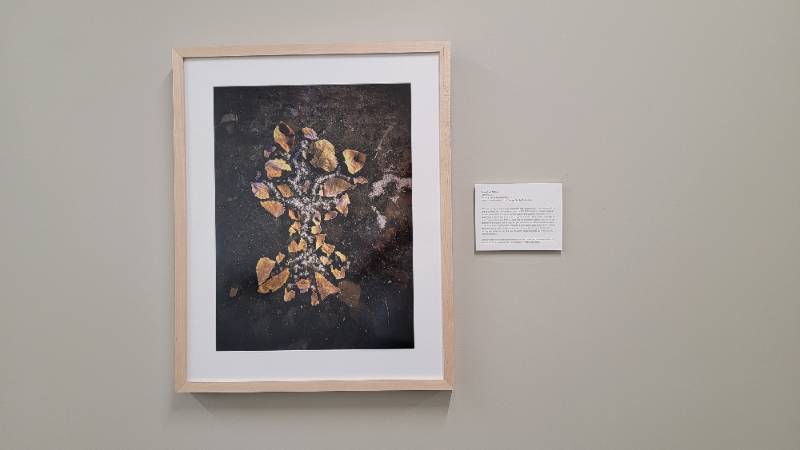
2020 was a year of many new challenges and uncertainties. This was specifically true
of colleges and universities across the US. With hands-on classes such as the arts
now unable to meet in person, faculty and students alike had to find a different,
but meaningful substitute to regular activities. Here at the University of North Dakota,
Professor Patrick Luber and his sculpture classes took this as an opportunity to express
art through simpler means. Inspired by the nature-centric works of Andrew Goldsworthy,
Professor Luber tasked each student with creating art in the natural world. Each student
was afforded the liberty to build and photograph whatever they felt expressed the
concept of land art while utilizing natural materials.
While the tree of life traditionally represents the connection between earth and heavens, it also represents the bond between mother and child.
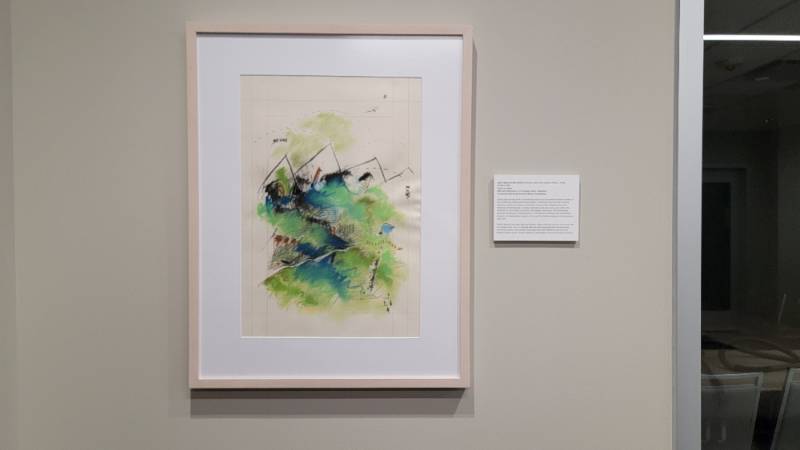
Jaune Quick-To-See Smith was born in St. Ignatius, Montana and is an enrolled member
of the Confederated Salish and Kootenai Tribes of the Flathead Indian Nation, Montana.
She received an Associate of Arts degree at Olympic College in Bremerton, Washington
in 1960, her Bachelor of Arts in Art Education from Framingham State College, Massachusetts
in 1976, and her Master of Arts in Visual Arts from the University of New Mexico in
1980.
Smith’s artwork may seem light and familiar, almost child-like, but her use of color tells us a deeper story. Her art contrasts abstract and representational elements while combining stylistic characteristics associated with both Western modern art and traditional native forms, visually addressing old traditions and current social concerns.

An alumnus of the University of North Dakota, David Thunderhawk graduated with a Bachelor
of Fine Arts in 2004. As a member of the Standing Rock Sioux Tribe with roots in Bismarck,
North Dakota, he has much experience working in graphic design and portraiture.
His incisive portrait explores the issue of identity. Thunderhawk states “as someone who is of a background that is equally Caucasian as it is Native American, I have struggled with what such a mixed background means to me at an artistic level.” Self Portrait serves as a representation of the self-reflection of his personal identity rather than merely his physical appearance.
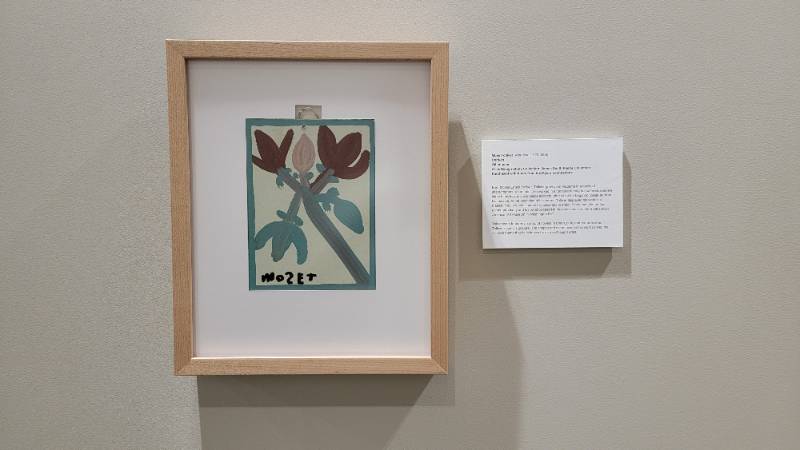
Born Moses Ernest Tolliver, Tolliver grew up in Alabama in a family of sharecroppers.
As an adult, he worked in a furniture factory but suffered a severe injury to his
legs in a workplace accident, after which he began to create art from his bedside.
At the beginning of his career, Tolliver displayed his work in a makeshift gallery
on his porch for passersby to enjoy. Since then, his art has gained popularity and
is now showcased in museums such as the Smithsonian American Art Museum in Washington
D.C.
This artwork features an array of flowers in green, pink, and red as well as Tolliver’s iconic signature. The shapes and colors used in this work convey the childlike theme that he is known for as a self-taught artist.
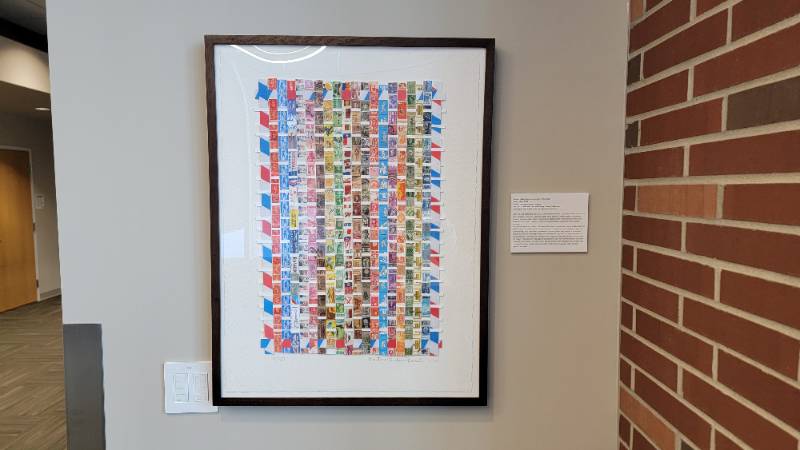
After his 1986 diagnosis with AIDS, Barton Benes entered a dry spell when it came
to art and inspiration. However, upon the death of his partner, Howard Meyer, he became
inspired to create again. Using memories and stories from his life and the lives of
his loved ones, he began making art that represented deeper meanings of the human
experience.
This piece comes from the end of Benes’ life, when he was using his art to take back the power that AIDS took from him. The interwoven postage stamps and bright colors can be interpreted as a unification of difference cultures, times, and people. It should be noted that some of the stamps depict the confederate flag. This is a very controversial design decision. However, the inclusion of the flag, although representing a dark time in US history, enhances the message of taking power back from something that has been historically oppressive. The interwoven stamps of this piece represent how diverse and complicated history can be, and as the title implies, there is always room to come together and reflect.
Third Floor Art
The Memorial Union serves as the heart of both UND and its student body. It is the physical embodiment of the unification of our campus community. Each of the floors of the building has a different experience to offer, a parallel to the diversity of our students, faculty, staff, etc. From dining and live music and meeting accommodations, to peaceful study sessions, the MU has something to offer for all members of campus.
The third floor of the Union is a calm, quiet space dedicated for those hard working students who need a quiet space to study, read a book, or complete assignments. Students on the third floor of the Memorial Union are greeted with dozens of windows overlooking the UND campus. The vibrant natural light creates a comforting and warm glow to the various spaces. When choosing art for this space, the students decided that rather than disrupt this natural aurora, they would build upon it through their art selections. The third floor is a space to let the mind be free and focused. Its long hallways combined with large window views support a variety of options for art displays. Jackie McElroy’s North Dakota landscapes serve the purpose of connecting those on campus to the outside community without having an intruding presence. George Starcher’s pieces touch on the history of the University while providing personality to the space. Nonrepresentational pieces intellectually challenge the observer in a way that is creative while also non-threatening. The theme these artworks were curated around an attempt to build upon the serenity and calmness that the third floor currently provides, while enhancing creativity and imagination, and inspiring students to achieve their goals.
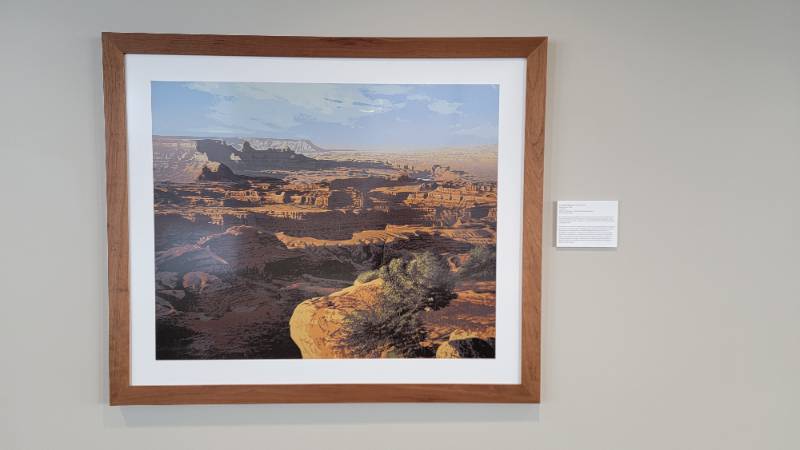
R. Geoffrey Blackburn studied at the University of Utah and studied privately but
considers himself a self-taught artist. After some years without much success, Blackburn’s
father-in-law got him a mining job, prospecting and promoting uranium.
Red Canyons is a result of a failed business venture that inspired Blackburn to escape in his artwork. The piece focuses on the landscape of a canyon with varieties of orange and red colors that contrast with the beautiful light blue coloring in the sky. The landscape is complete with the dark green shrubbery that can be seen in the bottom right corner of the painting. The canyons start to fade out in the back of the painting, where it starts to blend in with the color of the sky. These details help complete the landscape, adding to its realism. The large scale of this piece gives the viewer the feeling of standing at the edge of the canyon, looking over the land with a feeling of being on top of the world.
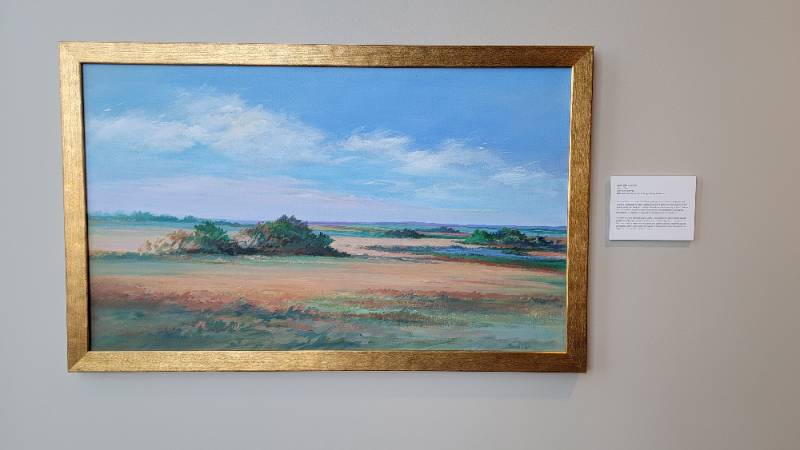
As a North Dakota native, Sandi Dahl grew up around the colorful plains and beautiful
landscapes of North Dakota. Living on a farm, she was inspired by the beauty in her
own backyard. Dahl graduated from the University of North Dakota with a Bachelor’s
degree in Home Economics. After graduation, she started traveling the US sharing her
artwork at national art fairs and galleries.
As many of Dahl’s artworks show, Mares Tales portrays a serene North Dakota landscape with prairie grasses and trees, and a blue sky with scattered clouds. The nature tells its own story throughout this piece of artwork. However, as the title states, Mares Tales invites the viewer to observe the prairie through the lens of the horses in the fields of North Dakota.
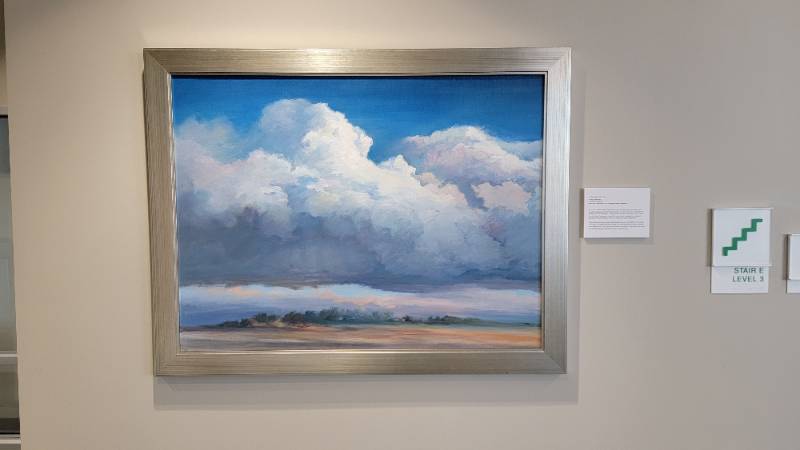
As a North Dakota native, Sandi Dahl grew up around the colorful plains and beautiful
landscapes of North Dakota. Living on a farm, she was inspired by the beauty in her
own backyard. Dahl graduated from the University of North Dakota with a Bachelor’s
degree in Home Economics. After graduation, she started traveling the US sharing her
artwork at national art fairs and galleries.
Prairie Olympus shows a cloudy North Dakota sky over the flat land. The clouds in the sky are overpowering the painting as if they represent the Mount Olympus of the Greek Gods. The clouds are the source of water for the grasses and prairie land of North Dakota, helping the land grow and develop.
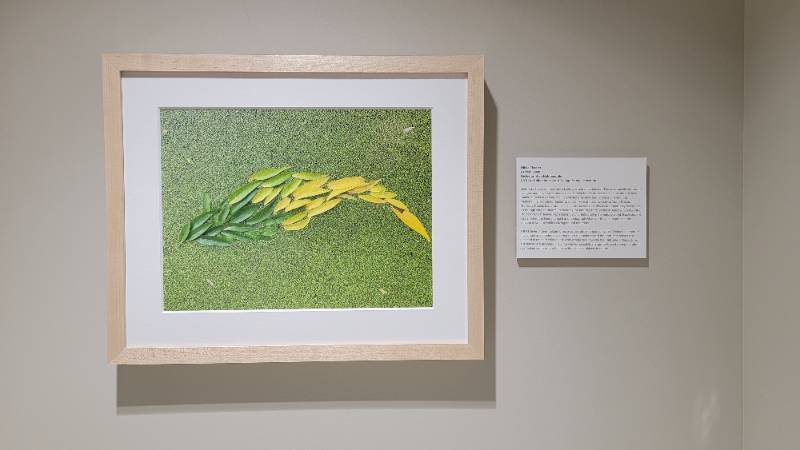
2020 was a year of many new challenges and uncertainties. This was specifically true
of colleges and universities across the US. With hands-on classes such as the arts
now unable to meet in person, faculty and students alike had to find a different,
but meaningful substitute to regular activities. Here at the University of North Dakota,
Professor Patrick Luber and his sculpture classes took this as an opportunity to express
art through simpler means. Inspired by the nature-centric works of Andrew Goldsworthy,
Professor Luber tasked each student with creating art in the natural world. Each student
was afforded the liberty to build and photograph whatever they felt expressed the
concept of land art while utilizing natural materials.
A thick layer of green algae forms a curtain above a body of water. Within the center of this curtain are slender leaves that taper to a point toward the right. The leaves also descend in tones of color as the work progresses towards the right side of the picture. The leaves are arranged in such a way to resemble a larger leaf, symbolizing the often-overlooked complexity within even the simplest objects in nature.
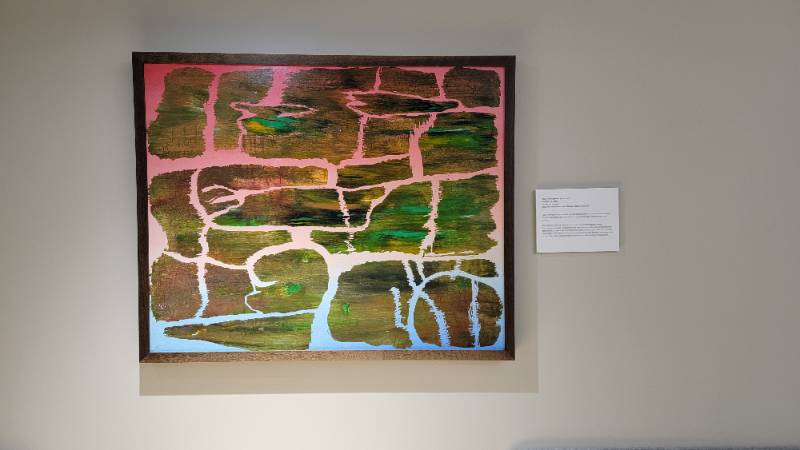
Paul Fundingsland possessed several artistic talents in his professional career. As
an art professor here at UND he taught photography, printmaking, and painting.
This artwork is one of many abstract and non-representational pieces Fundingsland created. Selected for this floor because of its non-representational abstractness, a piece like this allows the viewer’s mind to just relax and use their imagination. The colors are also calming, featuring a soft gradient from deep pink to blue. The yellow crackled forms add texture and the feeling of movement.
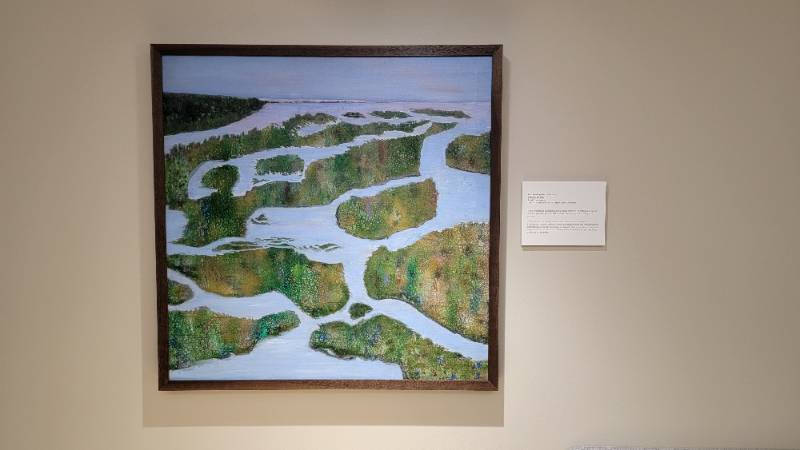
Paul Fundingsland possessed several artistic talents in his professional career. As
an art professor here at UND he taught photography, printmaking, and painting.
This artwork is one of many abstract and non-representational pieces Fundingsland created. Selected for this floor because of its non-representational abstractness, a piece like this allows the viewer’s mind to just relax and use their imagination. The colors are also calming, featuring a soft gradient from deep pink to blue. The yellow crackled forms add texture and the feeling of movement.
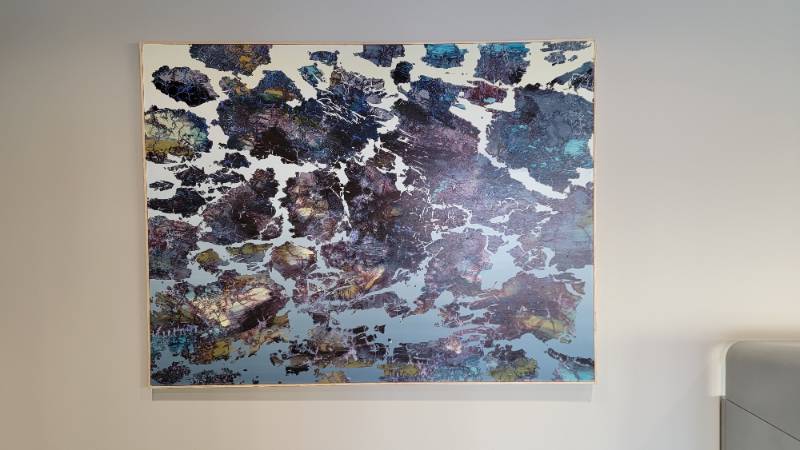
Paul Fundingsland possessed several artistic talents in his professional career. As
an art professor here at UND he taught photography, printmaking, and painting.
This artwork is one of many abstract and non-representational pieces Fundingsland created. Selected for this floor because of its non-representational abstractness, a piece like this allows the viewer’s mind to just relax and use their imagination. The colors are also calming, featuring a soft gradient from deep pink to blue. The yellow crackled forms add texture and the feeling of movement.
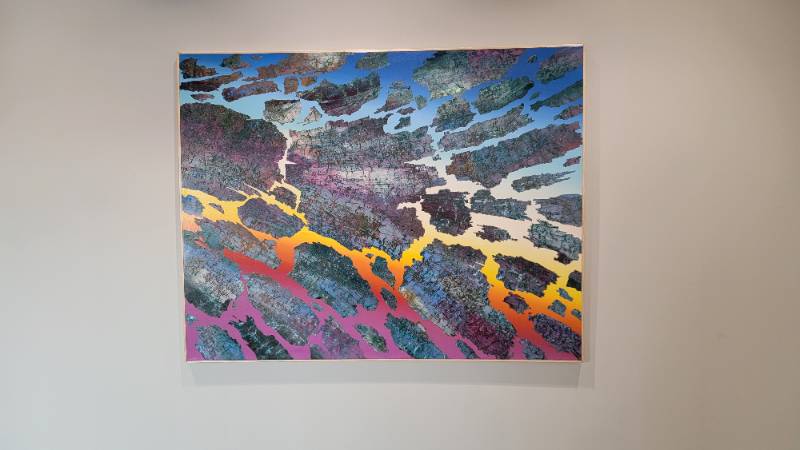
Paul Fundingsland possessed several artistic talents in his professional career. As
an art professor here at UND he taught photography, printmaking, and painting.
This artwork is one of many abstract and non-representational pieces Fundingsland created. Selected for this floor because of its non-representational abstractness, a piece like this allows the viewer’s mind to just relax and use their imagination. The colors are also calming, featuring a soft gradient from deep pink to blue. The yellow crackled forms add texture and the feeling of movement.
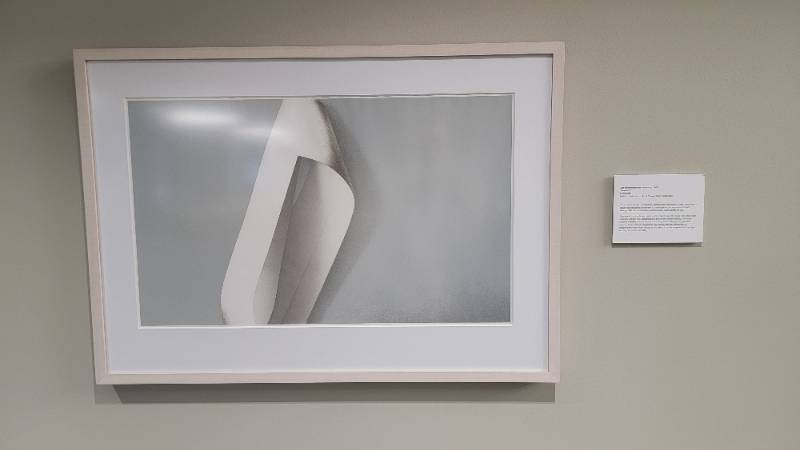
Sue Hettmansperger, a Professor Emerita at the University of Iowa, uses ideas of culture
and ecological awareness to create pieces that represent abstract feelings. She has
exhibited her work for many years across the US.
Template II is a simple piece with a white object being the focus. The white color contrasts with the grey background to give a very modern feeling. The object could be a feeling to focus on, the contrasting white with grey may give the viewer a feeling of hope against the dark clouds that can sometimes be experienced in life. When looking at this piece, it can be imagined that the object is a hug or embrace of safety.
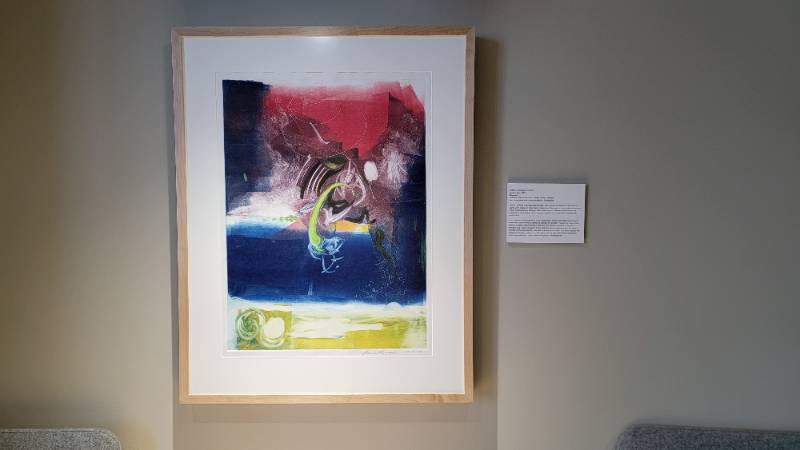
Sharon Linnehan is an artist and educator. She received her Bachelor of Fine Arts
at Saint Mary's College in Notre Dame, Indiana, and then went on to complete a Master
of Arts in Art Education at Michigan State University and a Master of Fine Arts at
the University of North Dakota. An etching press gives much of her work a colorful
and abstract look.
Color descends and ascends as the art progresses, showing the flashy beginnings of celebration, to the eventual fading and dullness of normality. Toward the center of the piece is a brightly colored streak, which seems to extend outward from the piece. However, this is soon consumed by the dark blue abyss below. Acting as if it were a firework, bright and colorful to only fade to darkness soon after. The piece displays two opposites interacting to form one. Portraying both the highs and lows of celebration which eventually blend to form the middle ground of everyday life.

Sharon Linnehan is an artist and educator. She received her Bachelor of Fine Arts
at Saint Mary's College in Notre Dame, Indiana, and then went on to complete a Master
of Arts in Art Education at Michigan State University and a Master of Fine Arts at
the University of North Dakota. An etching press gives much of her work a colorful
and abstract look.
This work features two distinct areas within the piece. Toward the top is a drab, yet at the same time, brightly colored skyline. Resembling the picturesque New York sunset. The interlocking cubes are used to portray the tops of buildings, the darker colors represent those deeper in the background. Below the NYC skyline is an accumulation of a variety of dark colors. These interlocking cubes represent the shadows cast by the buildings above onto the streets of NYC. The lack of definition of the cubes within this area is a means to portray the contrast between the glowing skyline and the drab streets below.
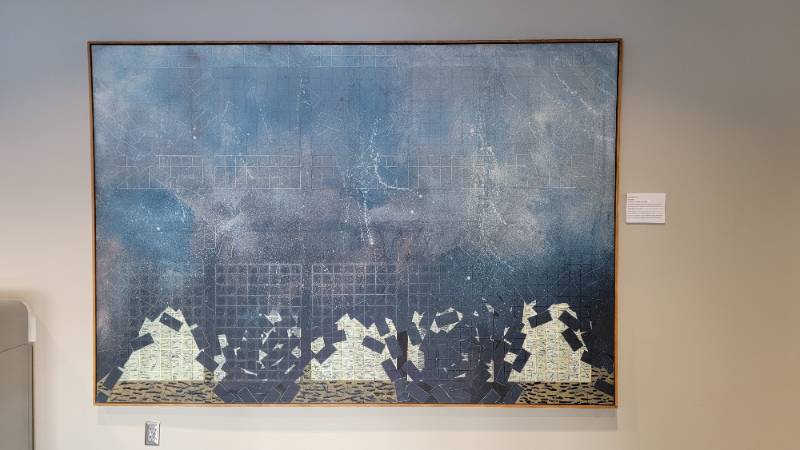
Born and raised in Grand Forks, North Dakota, Robert Matz studied and received his
Bachelor's degree in Education and his Master of Fine Arts in Visual Arts from the
University of North Dakota. Several of his art pieces were created when he attended
the University. Matz currently devotes his career to art education in Bismarck, North
Dakota, while he continues to make artwork.
Matz is known for his geometric abstract paintings. This artwork is an abstract constellation piece of the sky, and it is breaking up into different geometric shapes. The sky is a representation of one’s spirit and mind. With the artwork breaking up into different pieces, this shows that the mind is breaking free and able to express itself. The artwork starts as one whole piece, and gradually spreads apart. The enormity of this work invites the viewer to lose themselves in it, similarly to how they might feel while staring up at the sky.
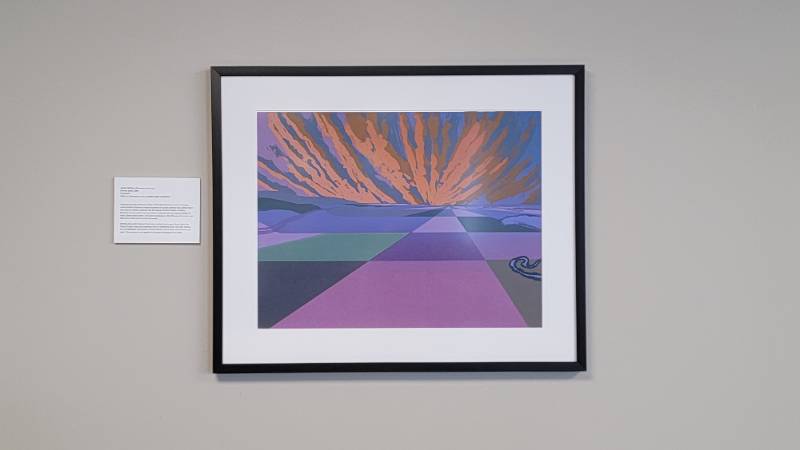
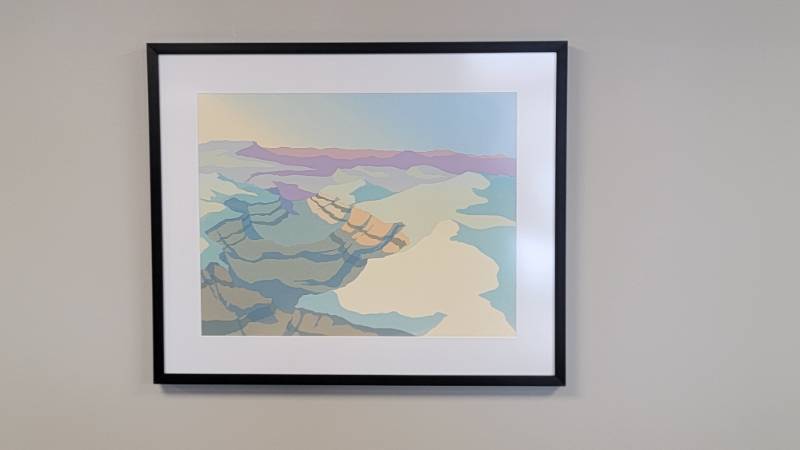
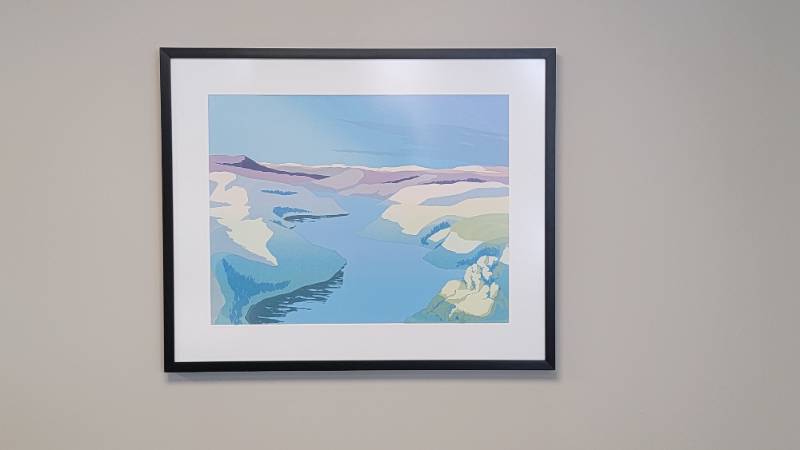
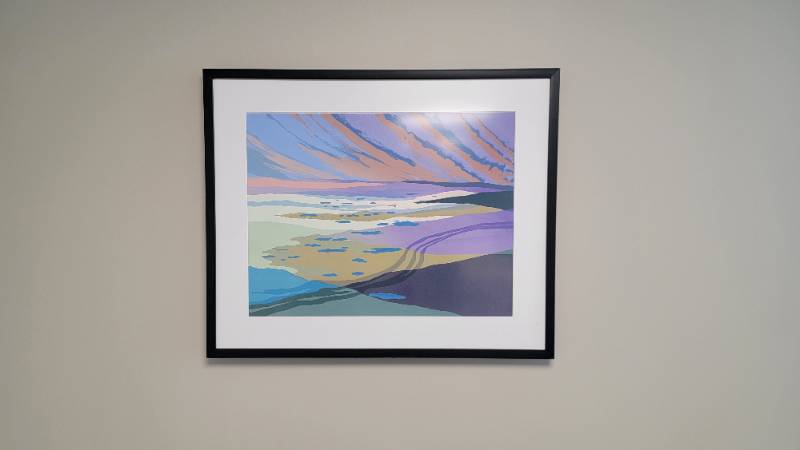
Professor Emerita and former Chair of the UND Department of Art & Design, Jackie McElroy-Edwards
created hundreds of surreal artworks that provide those who view her pieces a journey
into the beauty of North Dakota. McElroy-Edwards’s screen-prints were a method of
sharing what she and the people of North Dakota hold sacred – the iconic landscapes.
After 30 years of service, over 300 of her works remain at the University.
McElroy-Edwards’s Dakota Suite takes multiple landscapes found within the Peace Garden State and illustrates them in comforting hues. Her color choices turn the Badlands and prairies of North Dakota into a unique and mesmerizing sight. These pieces work together to illustrate the beauty of our state.
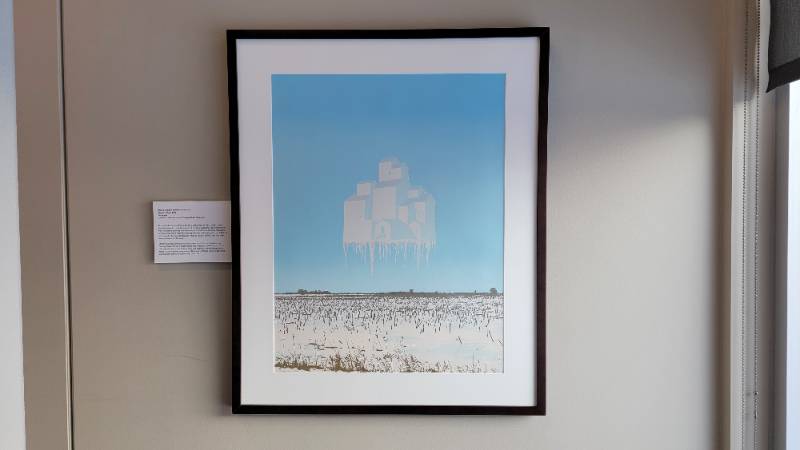
Former Professor and Chair of the UND Department of Art & Design, Jackie McElroy-Edwards
created thousands of surreal artworks that provide those who view her pieces a journey
into the beauty of North Dakota. McElroy-Edwards’s screen-prints were a method of
sharing what she and the people of North Dakota hold sacred – the iconic landscapes.
After 30 years of service, over 300 of her works remain at the University.
McElroy-Edwards continues her depiction of North Dakota’s landscape in January Thaw. We see a ghostly figure of an elevator, covered in ice. It floats over a prairie that appears free of frost. Like Titanic II, it is a message about North Dakota’s decline in agriculture. The farming lifestyle slowly freezes away as the prairie continues to grow and sustain life.
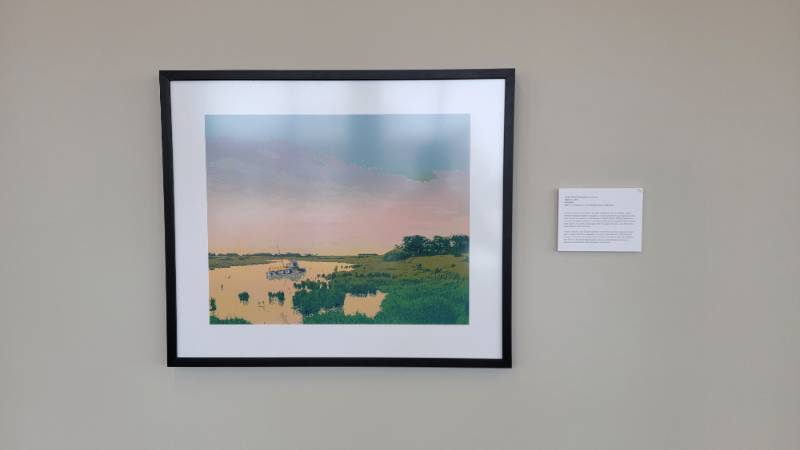
Former Professor and Chair of the UND Department of Art & Design, Jackie McElroy-Edwards
created thousands of surreal artworks that provide those who view her pieces a journey
into the beauty of North Dakota. McElroy-Edwards’s screen-prints were a method of
sharing what she and the people of North Dakota hold sacred – the iconic landscapes.
After 30 years of service, over 300 of her works remain at the University.
Titanic II depicts a set of grain elevators in the form of a ship. It appears tipped over in a lake covered in vegetation, pointing out the decline in the traditional farming culture that took roots in North Dakota. The water’s gold hue indicates that what we are losing should not be seen as a dreadful farewell but as a precious remembrance within the history of the state.
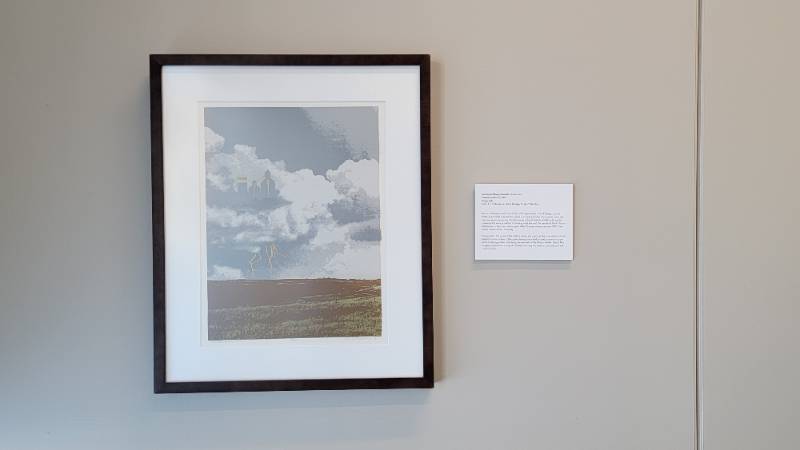
Former Professor and Chair of the UND Department of Art & Design, Jackie McElroy-Edwards
created thousands of surreal artworks that provide those who view her pieces a journey
into the beauty of North Dakota. McElroy-Edwards’s screen-prints were a method of
sharing what she and the people of North Dakota hold sacred – the iconic landscapes.
After 30 years of service, over 300 of her works remain at the University.
Compared to the works in the Dakota Suite, she captures the immortality of North Dakota’s iconic scenery. The grain elevators touched by gold accents are a part of the landscape, their roots being forever held in the Peace Garden State. This imagery implies how strong of a tradition farming has been in our state and will continue to be.

Born in Rolette North Dakota, Jessica Mongeon earned a Bachelor of Fine Arts from
the University of North Dakota, and a Master of Fine Arts in Painting from Montana
State University. Mongeon is a visual artist whose paintings often reflect the interconnectedness
of humans and nature.
In this interesting, understated work, the artist depicts three horses on a Midwestern plain. This combination of simplicity and sophistication might remind the viewer of the simplicity and sophistication of the great state of North Dakota. The painting is missing paint in places, inviting the viewer to imagine what might be or what might have been.
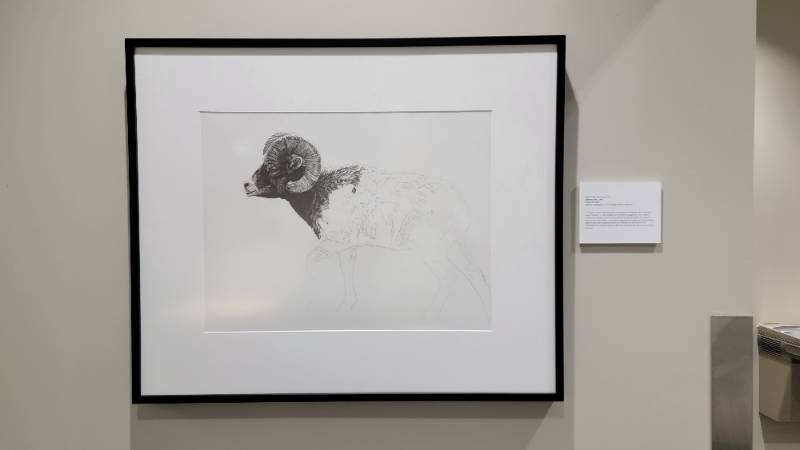
In this work, Henry Peterson gives us only part of the bighorn ram. The piece seems
unfished, or half complete as if something happened in the middle of creating the
artwork. Like the nearby work of Jessica Mongeon, the viewer is asked to fill in the
blanks – or perhaps imagine what is missing or what could be. Bighorn rams often represent
power and boldness, so leaving the work unfinished may represent that no matter how
strong we are, we are still a work in progress.
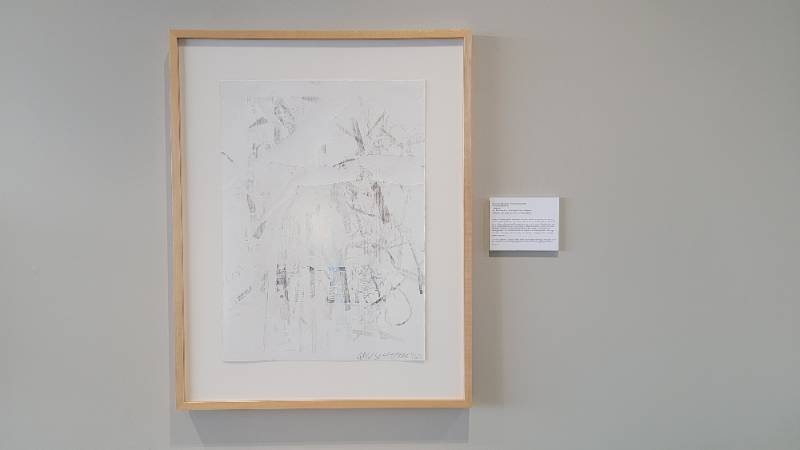
Robert Rauschenberg was a prominent artist who worked with painting, photography,
sculpture, performance, and other types of fine arts for six decades. His art came
to life during the time when Abstract Expressionism was up and coming. Rauschenberg
was one of the first artists to use the techniques of collage to create his pieces.
His unique expression of art also included collaboration with other artists like musicians
and choreographers. Two prominent names that inspired Rauschenberg were John Cage
and Merce Cunningham. Rauschenberg used elements of everyday life to inspire his collage
techniques.
No-Name Elephant is a good example of his use of collage techniques. The piece is very faint, using lots of white scraps of paper with some dark ink on it, giving the effect of anonymity.
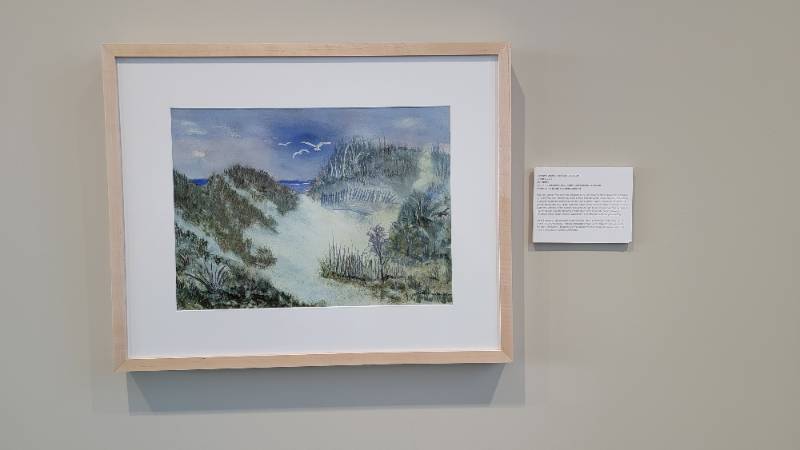
George Starcher was the ninth president of the University of North Dakota from 1954
to 1971. He was well regarded by those around him and by the University due to his
ability to accommodate the campus during this time of growth when enrollment had tripled.
It can be argued that UND didn’t suffer the same social unrest as other universities
due to Starcher’s defense of free speech, including the right to peacefully assemble.
A brilliant mathematician, Starcher became a more active artist in his later years
following retirement, most notably creating watercolors of landscapes and campus buildings.
The nonrepresentational monoprints created by Starcher create an almost kaleidoscopic image, not providing an explicit meaning. With the lack of recognizable shapes and figures, one can often be confused as they first contemplate the piece. His work challenges the viewer to interpret each piece through their observations, where their imagination can bring them to their own conclusions.
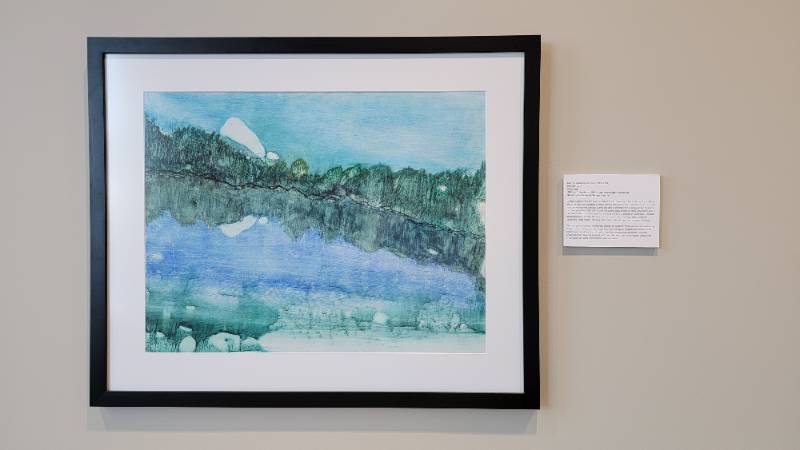
George Starcher was the ninth president of the University of North Dakota from 1954
to 1971. He was well regarded by those around him and by the University due to his
ability to accommodate the campus during this time of growth when enrollment had tripled.
It can be argued that UND didn’t suffer the same social unrest as other universities
due to Starcher’s defense of free speech, including the right to peacefully assemble.
A brilliant mathematician, Starcher became a more active artist in his later years
following retirement, most notably creating watercolors of landscapes and campus buildings.
The nonrepresentational monoprints created by Starcher create an almost kaleidoscopic image, not providing an explicit meaning. With the lack of recognizable shapes and figures, one can often be confused as they first contemplate the piece. His work challenges the viewer to interpret each piece through their observations, where their imagination can bring them to their own conclusions.
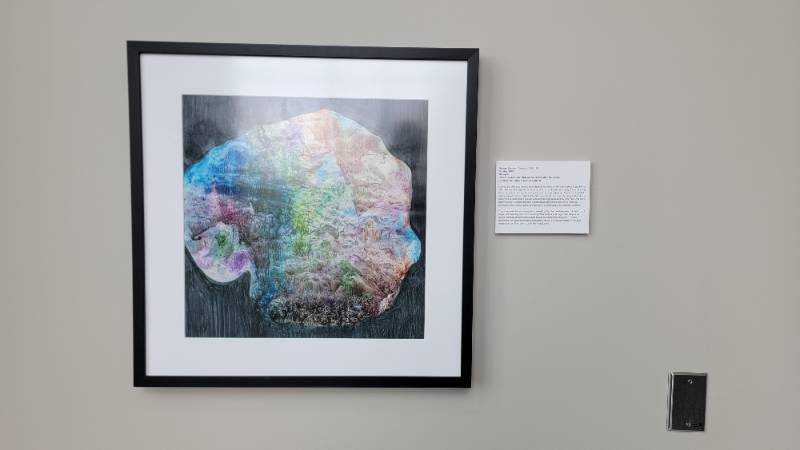
George Starcher was the ninth president of the University of North Dakota from 1954
to 1971. He was well regarded by those around him and by the University due to his
ability to accommodate the campus during this time of growth when enrollment had tripled.
It can be argued that UND didn’t suffer the same social unrest as other universities
due to Starcher’s defense of free speech, including the right to peacefully assemble.
A brilliant mathematician, Starcher became a more active artist in his later years
following retirement, most notably creating watercolors of landscapes and campus buildings.
The nonrepresentational monoprints created by Starcher create an almost kaleidoscopic image, not providing an explicit meaning. With the lack of recognizable shapes and figures, one can often be confused as they first contemplate the piece. His work challenges the viewer to interpret each piece through their observations, where their imagination can bring them to their own conclusions.
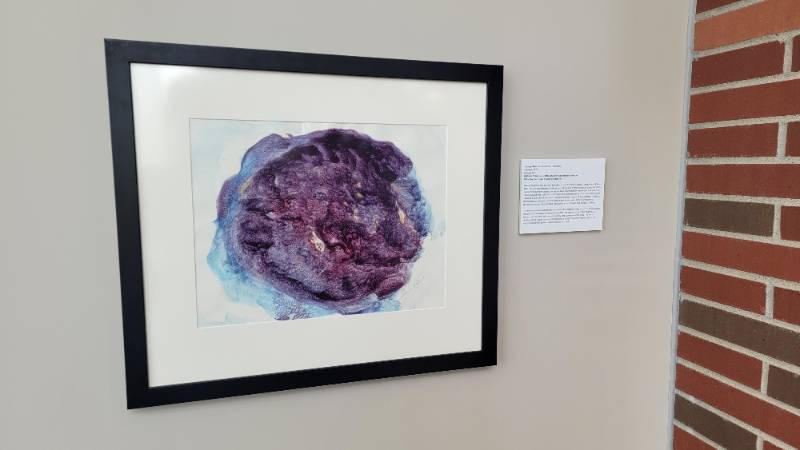
George Starcher was the ninth president of the University of North Dakota from 1954
to 1971. He was well regarded by those around him and by the University due to his
ability to accommodate the campus during this time of growth when enrollment had tripled.
It can be argued that UND didn’t suffer the same social unrest as other universities
due to Starcher’s defense of free speech, including the right to peacefully assemble.
A brilliant mathematician, Starcher became a more active artist in his later years
following retirement, most notably creating watercolors of landscapes and campus buildings.
While Starcher’s representational art presents less of a challenge to the observer, it should not be overlooked. Familiar landscapes make up the subject of his watercolors. Starcher’s depiction of beaches and mountains invites a feeling of calm serenity that sends a message of comfort and warmth.
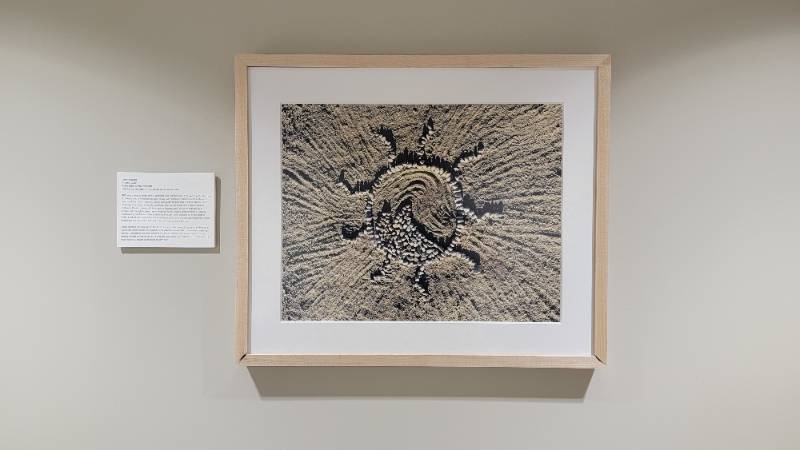
2020 was a year of many new challenges and uncertainties. This was specifically true
of colleges and universities across the US. With hands-on classes such as the arts
now unable to meet in person, faculty and students alike had to find a different,
but meaningful substitute to regular activities. Here at the University of North Dakota,
Professor Patrick Luber and his sculpture classes took this as an opportunity to express
art through simpler means. Inspired by the nature-centric works of Andrew Goldsworthy,
Professor Luber tasked each student with creating art in the natural world. Each student
was afforded the liberty to build and photograph whatever they felt expressed the
concept of land art while utilizing natural materials.
Small pebbles are arranged in the form of a sun, with arms jutting out in all directions. Within the center of the sun appear to be pebbles assembled to symbolize crashing waves. Connecting two core aspects of nature and the world as a whole. Shadows extend toward the top of the sun giving the work depth and structure, to symbolize the many layers of nature connecting to form one.
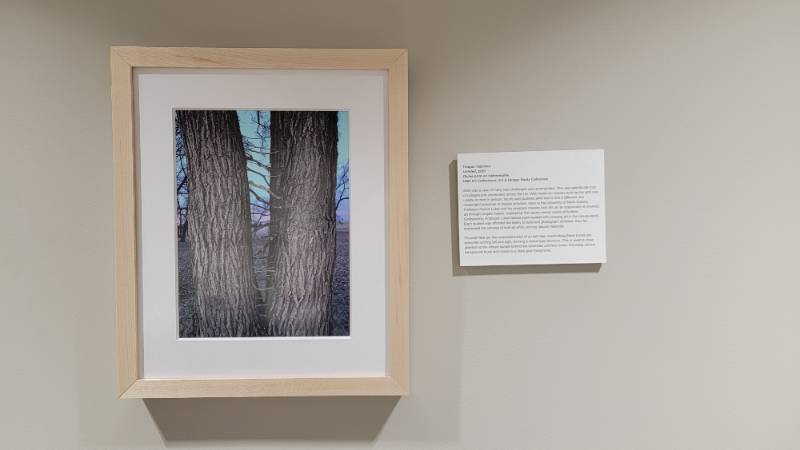
2020 was a year of many new challenges and uncertainties. This was specifically true
of colleges and universities across the US. With hands-on classes such as the arts
now unable to meet in person, faculty and students alike had to find a different yet
meaningful substitute to regular activities. Here at the University of North Dakota,
Professor Patrick Luber and his sculpture classes took this as an opportunity to express
art through simpler means. Inspired by the nature-centric works of Andrew Goldsworthy,
Professor Luber tasked each student with creating art in the natural world. Each student
was afforded the liberty to build and photograph whatever they felt expressed the
concept of land art while utilizing natural materials.
Pictured here are the conjoined trunks of an ash tree. Interlocking these trunks are branches running left and right, forming a lattice type structure. This is used to draw attention to the vibrant sunset behind the otherwise colorless trees. Providing vibrant background blues and violets to a stark gray foreground.
Lower Level Art
The addition of artwork into any space changes the atmosphere of that space and the feelings felt by those within it. As the Union is a space for people to come to study, enjoy food, gather for events, or simply to just relax, it only felt necessary and proper for art to be added to the walls. With the addition of artwork, the various spaces in the Union are transformed to promote a welcoming and uplifting atmosphere.
The artwork on the lower level of the Union was chosen with the purpose of creating a fun and lively atmosphere. The main theme behind the artwork for this level is ‘fun and games’, since it is the place many go for recreational activity. This can be clearly seen by the variety of game related and colorful pieces which range from a 1930s pinball game to geometric pieces with bold and vibrant colors, including the iconic kelly green in the Ellsworth Kelly piece, Green Curve with a Radius of 20'. Seeing these pieces of art stimulate positivity and fun within the viewers and reinforce the mood of the environment.
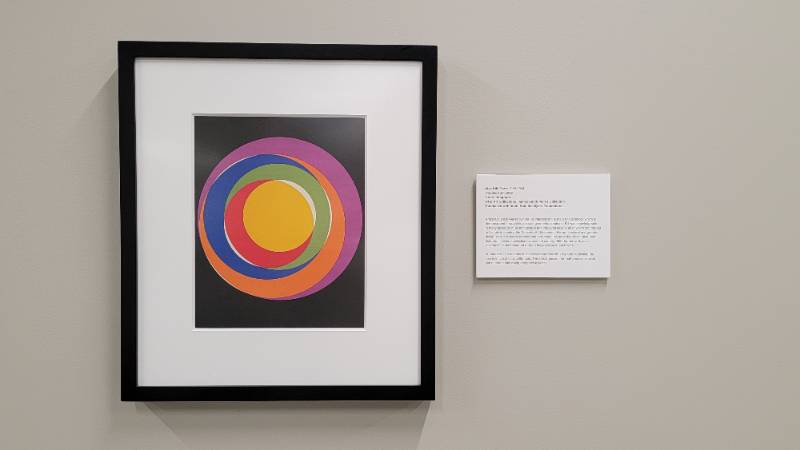
Max Bill was an architect, painter, industrial designer, and graphic designer born
in 1908 in Winterthur, Switzerland. Bill first trained as a silversmith at the Zurich
School of Applied Art from 1924 to 1927 until he went on to study at the Bauhaus from
1927 to 1929. Max Bill is best known for his concrete art methods, which center on
geometric abstraction, that sought to present the viewers with a visual representation
of the new sciences that were emerging in the early 20th century. Max Bill has work
in the permanent collections of the Modern Museum of Art, the Art Institute of Chicago,
and several others.
Max Bill created Variation 13 for the fourth issue of the Paris art magazine XXe Siècle. Bill is most well known for starting the Concrete Art Movement, his architecture and graphic design, most of which followed more modern and industrial styles.
Variation 13 was created during Bill’s ‘Variation Period’. Most of his works from this time feature a similar mix of either bright colors or black and white geometric shapes on plain backgrounds.
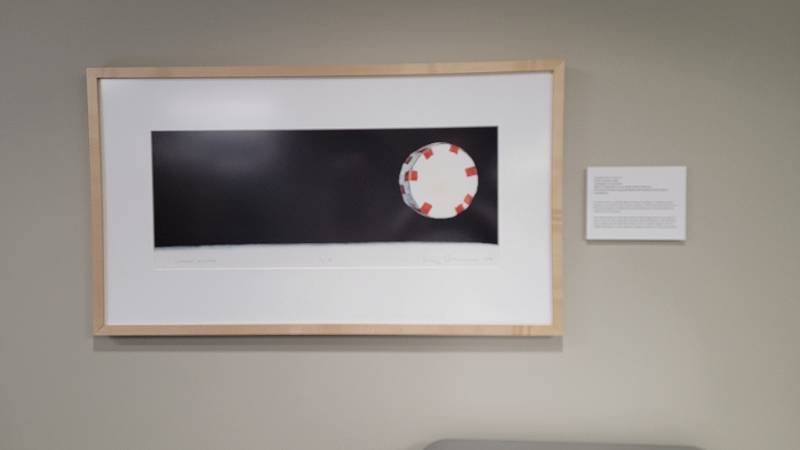
Craig Drennen is a Georgia State University art professor. Creating primarily paintings,
he is fluent in many artistic mediums. In 2006, Drennen visited Grand Forks and curated
an exhibition for the 2014 UND Arts & Culture Conference, titled Cultures of Curation.
This artwork shows a single poker chip as it falls through the air. In the game of poker, there are risks associated with every hand and decision. Some decisions result in great reward, while others result in loss. In Certain Senator, Drennen implies that politics is a kind of game containing its own set of risks and rewards.
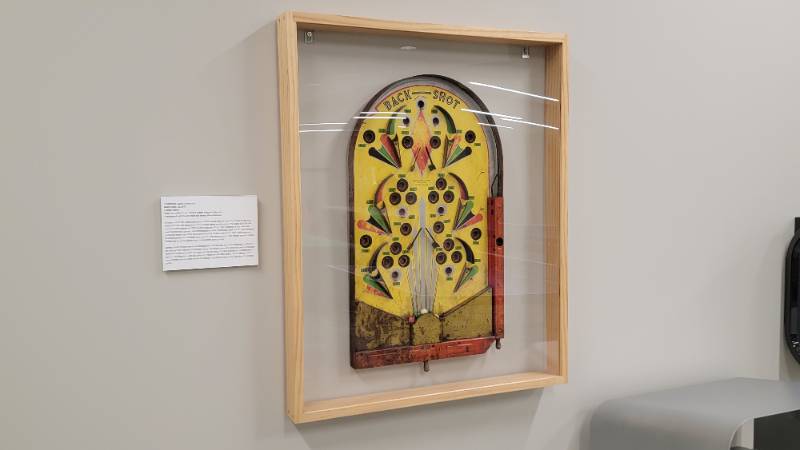
Lindstrom Corp created the Back-shot Pinball machine in 1933. Beginning in 1932, Lindstrom Corp released 22 different machines under the tradename. Back-shot Pinball is a skill-based ball-dropping game that is dependent upon gravity. During this era of Pinball, the machines were made of wooden legs and wooden rails on the machine’s side. Their popularity grew in the 1930s in response to the Great Depression and the need for low-cost entertainment for the population.
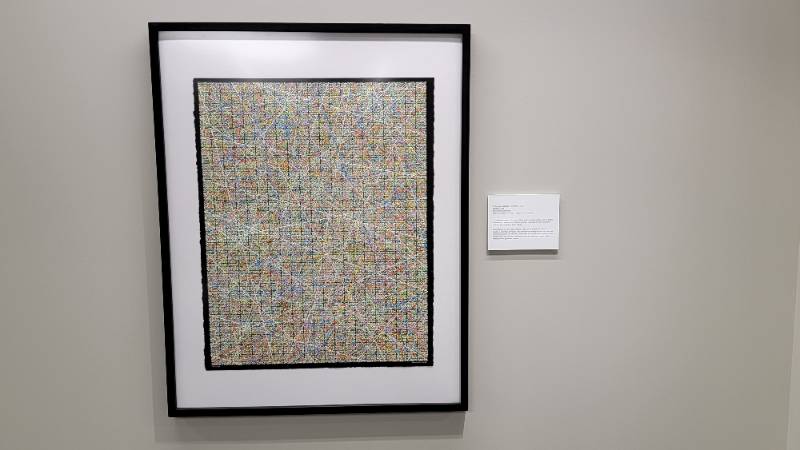
C. Guastella earned his Bachelor of Fine Arts from Wayne State, and his Master of
Fine Arts in painting from Eastern Michigan University. He later accepted a professorship
position in South Dakota.
Guastella has over the years become known for his patterns of line work, creating a geometric formation. This dimensional painting features thin line work of numerous colors that allow for a closer look into the depth of the painting. This artwork invites the viewer to stop and observe the overlapping layers of line forming several geometric shapes.
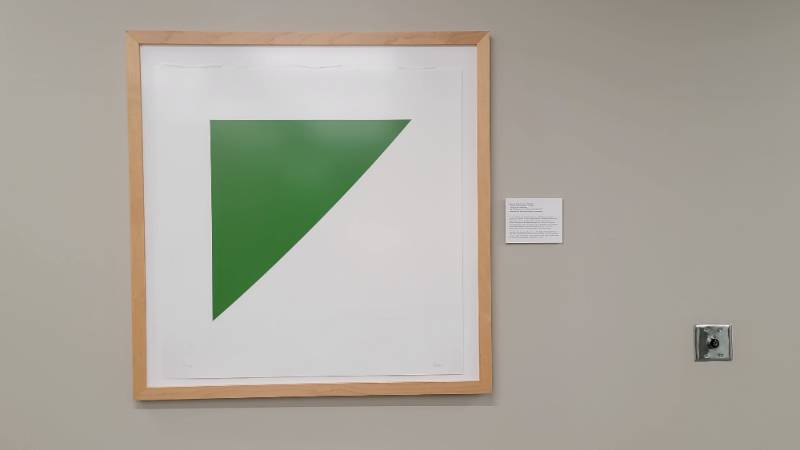
In 1951, Ellsworth Kelly submitted a grant to the Guggenheim Foundation, proposing
“an alphabet of plastic pictorial elements”, with hopes of there being closer contact
between the artist and the wall. Although his application was rejected, his plastic
pictorial elements project came to life with the drawings known as Line Form Color.
The American artist is best known for his hard-edge paintings that included the use
of intense colors and geometric shapes. His works majorly influenced pop art, minimalism,
and color field painting.
Like much of his other work, Green Curve with a Radius of 20’ exemplifies pure form, color, and spatial unity. The title of this piece comes from the triangle being a part of a larger circle that has a radius of 20 feet. At first glance, the piece looks like a perfect triangle, although its hypotenuse is curved.
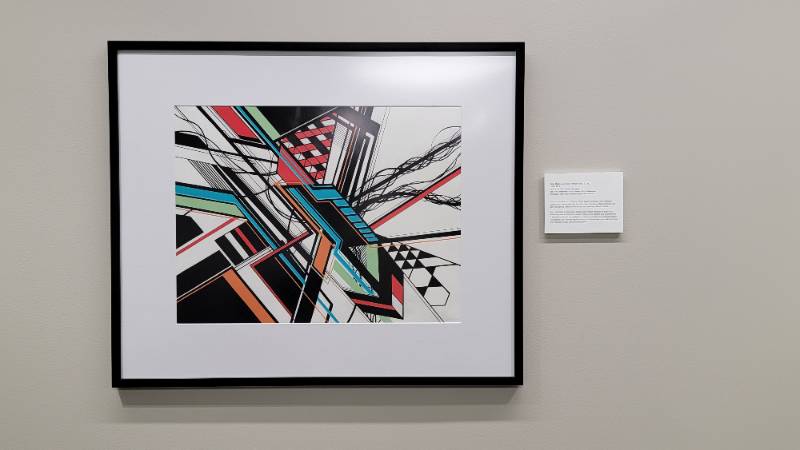
Cody Marks was born in Yankton, South Dakota, and grew up in Aberdeen, South Dakota.
He received his Bachelor of Art at Northern State University and later received his
Master of Fine Arts at the University of North Dakota.
Being dedicated to abstraction, Marks fuses various elements of graffiti with different geometric forms in his artwork. Many of the patterns and arrangements in his various abstract forms reference and are inspired by his ancestral heritage. For example, the color red signifies life and is a friendly welcome, and the zig-zag lines represent prayer and its unifying power.
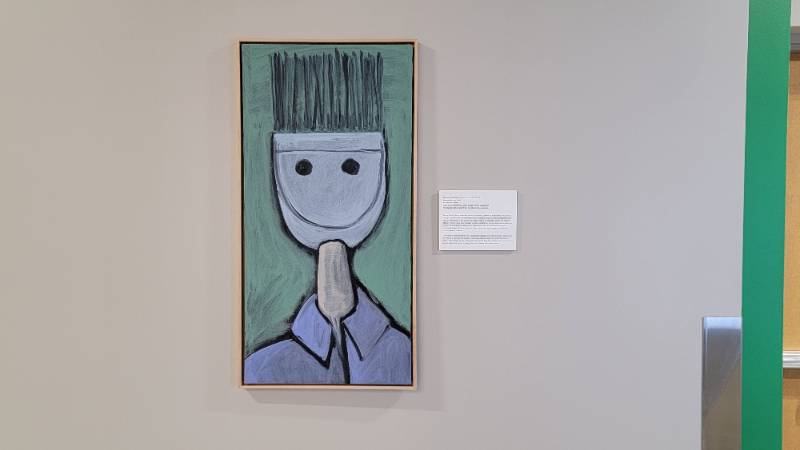
James Smith Pierce attended Harvard University, where he received his PhD in art history.
In addition to his contributions to the history of art, he also contributed to the
land art movement in the 1970s and 1980s, where he exhibited across the United States.
Pierce’s work was included in many exhibitions, one of which was a show on land art
at the Hirshhorn Museum in Washington, DC. In addition to being an accomplished art
historian and artist, Pierce was also a photographer, exhibition curator, and art
collector.
The Artiste-Peintre painting is of a paintbrush situated on a figure’s body, which gives the viewer a clue that this painting might be a self-portrait of the artist, hence the name. This painting is one of several other pieces from his portfolio that contain some type of whimsical figure, showing the artist’s sense of fun and humor.
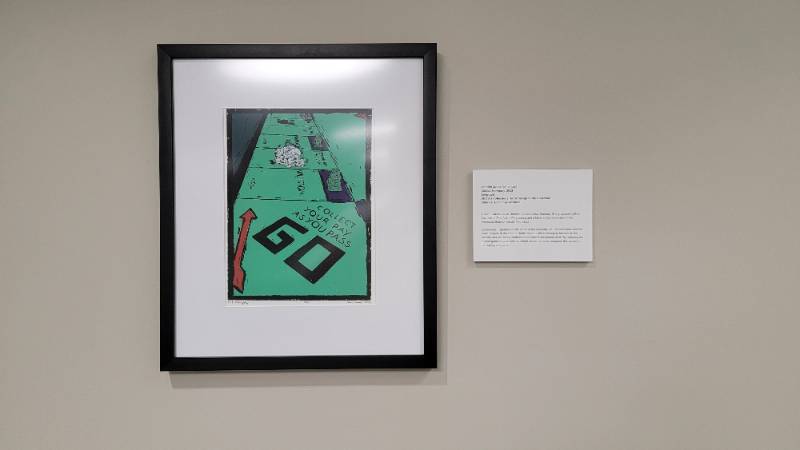
A North Dakota native, Jennifer Junker is from Mandan. She graduated with a Bachelor
of Fine Arts in Printmaking and a Minor in Communication from Minnesota State University
Moorhead.
Junker finds inspiration for her works in her everyday life. Oil fields have become iconic imagery in the state of North Dakota. Oilfield Monopoly focuses on the industry and the money workers chase while in pursuit of oil. By replacing the original game squares with an oilfield theme, the artist compares this pursuit to the playing of a game.
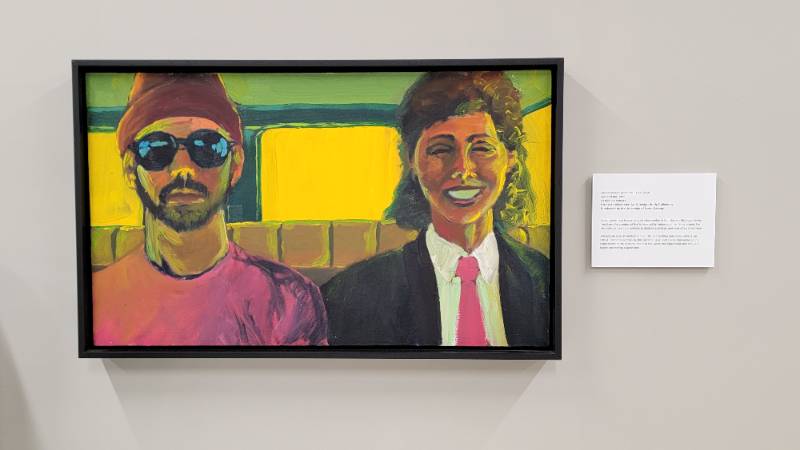
Janet Lokken is a freelance artist who resides in Ann Arbor, Michigan. In her free
time, she creates art that is inspired by nature and the things around her. Her work
ranges from portraits to abstract paintings and everything in between.
Jim and Me is a self-portrait of the artist and another individual within a car. Unlike traditional portraiture, this painting uses vivid colors that reinforce the expressions of the subjects and give the viewer the impression that they are happy and having a good time.
Student Curatorial Teams
Lower Level, First Floor: Faith Hoverson, Tyler Gohmann, Austin Pierce, Greyson Gutzmer, Hailey Thiessen
Second Floor: Caroline Kelley, Alivia Adams, Rylee Bergeron, Carter Schofield, Brock Schultz
Third Floor: McKenzie Tindall, Luca Beretta, Faith Hallem, Hayden Thompson, Sydney Crockett, Kristian Herman
UND Living Museums
The campus features 13 Living Museums to explore in addition to the Memorial Union.